Advanced Diploma in Business - Manage knowledge and information
VerifiedAdded on 2023/06/13
|23
|8043
|252
AI Summary
This document covers various topics related to managing knowledge and information in the context of fitness centres. It includes examples of technologies relevant to fitness centres, statistical analysis and quantitative methods, management information systems, decision support systems, and risk management plans. The document also includes a case study analysis of Bounce Fitness and defines the business problems and ideal solutions. Additionally, it provides study tips and research sources for further reading.
Contribute Materials
Your contribution can guide someone’s learning journey. Share your
documents today.
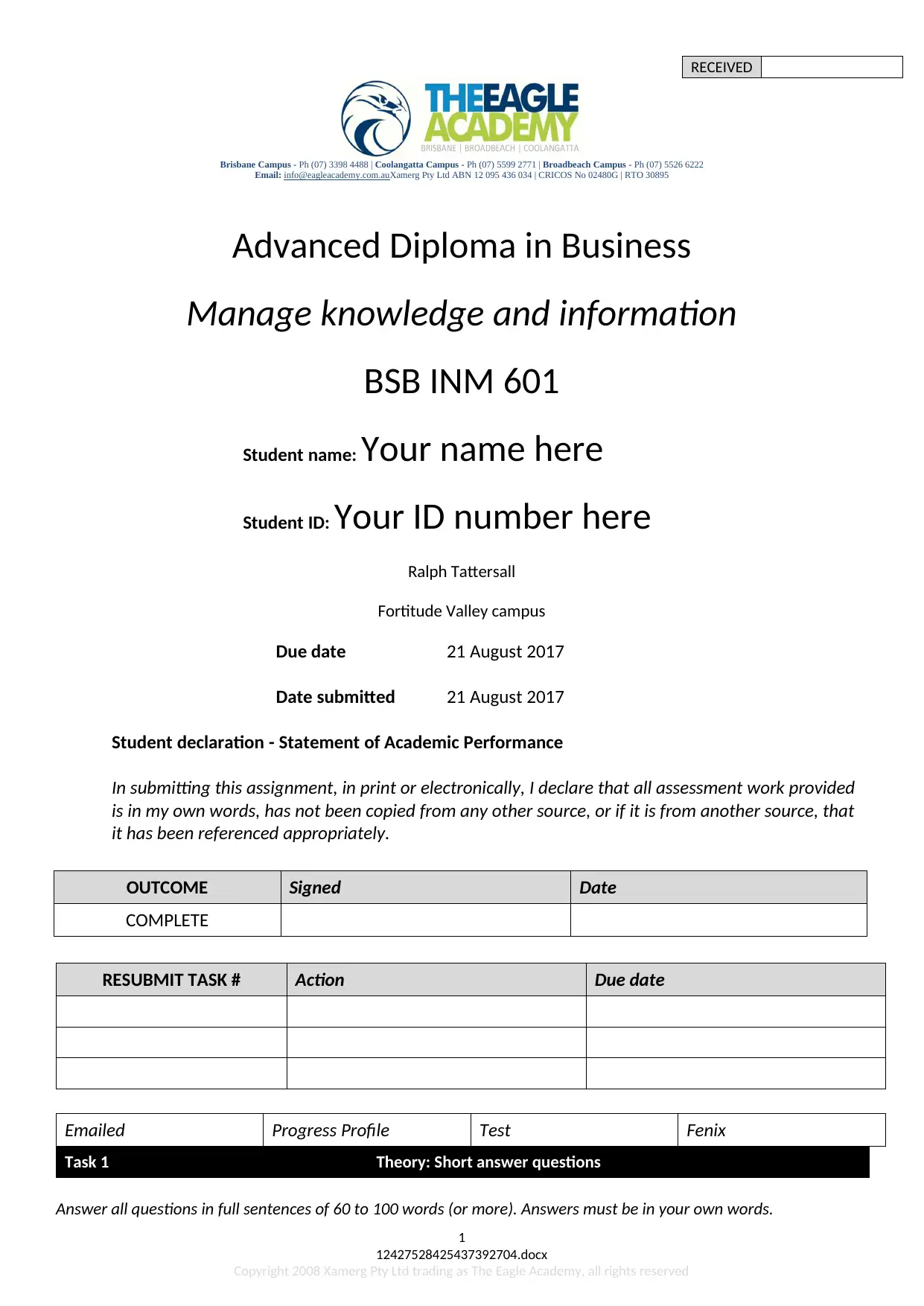
RECEIVED
Brisbane Campus - Ph (07) 3398 4488 | Coolangatta Campus - Ph (07) 5599 2771 | Broadbeach Campus - Ph (07) 5526 6222
Email: info@eagleacademy.com.auXamerg Pty Ltd ABN 12 095 436 034 | CRICOS No 02480G | RTO 30895
Advanced Diploma in Business
Manage knowledge and information
BSB INM 601
Student name: Your name here
Student ID: Your ID number here
Ralph Tattersall
Fortitude Valley campus
Due date 21 August 2017
Date submitted 21 August 2017
Student declaration - Statement of Academic Performance
In submitting this assignment, in print or electronically, I declare that all assessment work provided
is in my own words, has not been copied from any other source, or if it is from another source, that
it has been referenced appropriately.
OUTCOME Signed Date
COMPLETE
RESUBMIT TASK # Action Due date
Emailed Progress Profile Test Fenix
Task 1 Theory: Short answer questions
Answer all questions in full sentences of 60 to 100 words (or more). Answers must be in your own words.
1
12427528425437392704.docx
Copyright 2008 Xamerg Pty Ltd trading as The Eagle Academy, all rights reserved
Brisbane Campus - Ph (07) 3398 4488 | Coolangatta Campus - Ph (07) 5599 2771 | Broadbeach Campus - Ph (07) 5526 6222
Email: info@eagleacademy.com.auXamerg Pty Ltd ABN 12 095 436 034 | CRICOS No 02480G | RTO 30895
Advanced Diploma in Business
Manage knowledge and information
BSB INM 601
Student name: Your name here
Student ID: Your ID number here
Ralph Tattersall
Fortitude Valley campus
Due date 21 August 2017
Date submitted 21 August 2017
Student declaration - Statement of Academic Performance
In submitting this assignment, in print or electronically, I declare that all assessment work provided
is in my own words, has not been copied from any other source, or if it is from another source, that
it has been referenced appropriately.
OUTCOME Signed Date
COMPLETE
RESUBMIT TASK # Action Due date
Emailed Progress Profile Test Fenix
Task 1 Theory: Short answer questions
Answer all questions in full sentences of 60 to 100 words (or more). Answers must be in your own words.
1
12427528425437392704.docx
Copyright 2008 Xamerg Pty Ltd trading as The Eagle Academy, all rights reserved
Secure Best Marks with AI Grader
Need help grading? Try our AI Grader for instant feedback on your assignments.
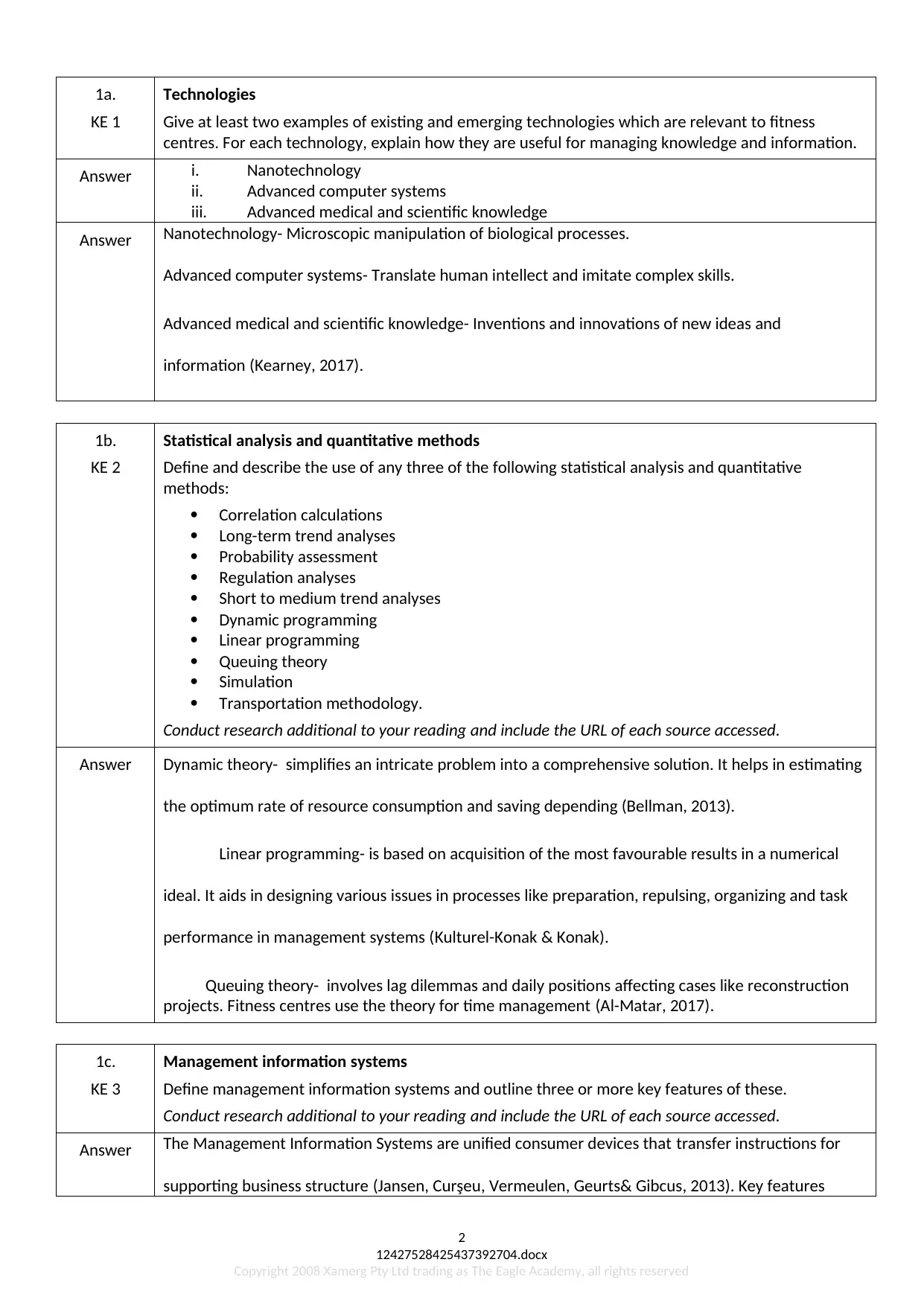
1a.
KE 1
Technologies
Give at least two examples of existing and emerging technologies which are relevant to fitness
centres. For each technology, explain how they are useful for managing knowledge and information.
Answer i. Nanotechnology
ii. Advanced computer systems
iii. Advanced medical and scientific knowledge
Answer Nanotechnology- Microscopic manipulation of biological processes.
Advanced computer systems- Translate human intellect and imitate complex skills.
Advanced medical and scientific knowledge- Inventions and innovations of new ideas and
information (Kearney, 2017).
1b.
KE 2
Statistical analysis and quantitative methods
Define and describe the use of any three of the following statistical analysis and quantitative
methods:
Correlation calculations
Long-term trend analyses
Probability assessment
Regulation analyses
Short to medium trend analyses
Dynamic programming
Linear programming
Queuing theory
Simulation
Transportation methodology.
Conduct research additional to your reading and include the URL of each source accessed.
Answer Dynamic theory- simplifies an intricate problem into a comprehensive solution. It helps in estimating
the optimum rate of resource consumption and saving depending (Bellman, 2013).
Linear programming- is based on acquisition of the most favourable results in a numerical
ideal. It aids in designing various issues in processes like preparation, repulsing, organizing and task
performance in management systems (Kulturel-Konak & Konak).
Queuing theory- involves lag dilemmas and daily positions affecting cases like reconstruction
projects. Fitness centres use the theory for time management (Al-Matar, 2017).
1c.
KE 3
Management information systems
Define management information systems and outline three or more key features of these.
Conduct research additional to your reading and include the URL of each source accessed.
Answer The Management Information Systems are unified consumer devices that transfer instructions for
supporting business structure (Jansen, Curşeu, Vermeulen, Geurts& Gibcus, 2013). Key features
2
12427528425437392704.docx
Copyright 2008 Xamerg Pty Ltd trading as The Eagle Academy, all rights reserved
KE 1
Technologies
Give at least two examples of existing and emerging technologies which are relevant to fitness
centres. For each technology, explain how they are useful for managing knowledge and information.
Answer i. Nanotechnology
ii. Advanced computer systems
iii. Advanced medical and scientific knowledge
Answer Nanotechnology- Microscopic manipulation of biological processes.
Advanced computer systems- Translate human intellect and imitate complex skills.
Advanced medical and scientific knowledge- Inventions and innovations of new ideas and
information (Kearney, 2017).
1b.
KE 2
Statistical analysis and quantitative methods
Define and describe the use of any three of the following statistical analysis and quantitative
methods:
Correlation calculations
Long-term trend analyses
Probability assessment
Regulation analyses
Short to medium trend analyses
Dynamic programming
Linear programming
Queuing theory
Simulation
Transportation methodology.
Conduct research additional to your reading and include the URL of each source accessed.
Answer Dynamic theory- simplifies an intricate problem into a comprehensive solution. It helps in estimating
the optimum rate of resource consumption and saving depending (Bellman, 2013).
Linear programming- is based on acquisition of the most favourable results in a numerical
ideal. It aids in designing various issues in processes like preparation, repulsing, organizing and task
performance in management systems (Kulturel-Konak & Konak).
Queuing theory- involves lag dilemmas and daily positions affecting cases like reconstruction
projects. Fitness centres use the theory for time management (Al-Matar, 2017).
1c.
KE 3
Management information systems
Define management information systems and outline three or more key features of these.
Conduct research additional to your reading and include the URL of each source accessed.
Answer The Management Information Systems are unified consumer devices that transfer instructions for
supporting business structure (Jansen, Curşeu, Vermeulen, Geurts& Gibcus, 2013). Key features
2
12427528425437392704.docx
Copyright 2008 Xamerg Pty Ltd trading as The Eagle Academy, all rights reserved
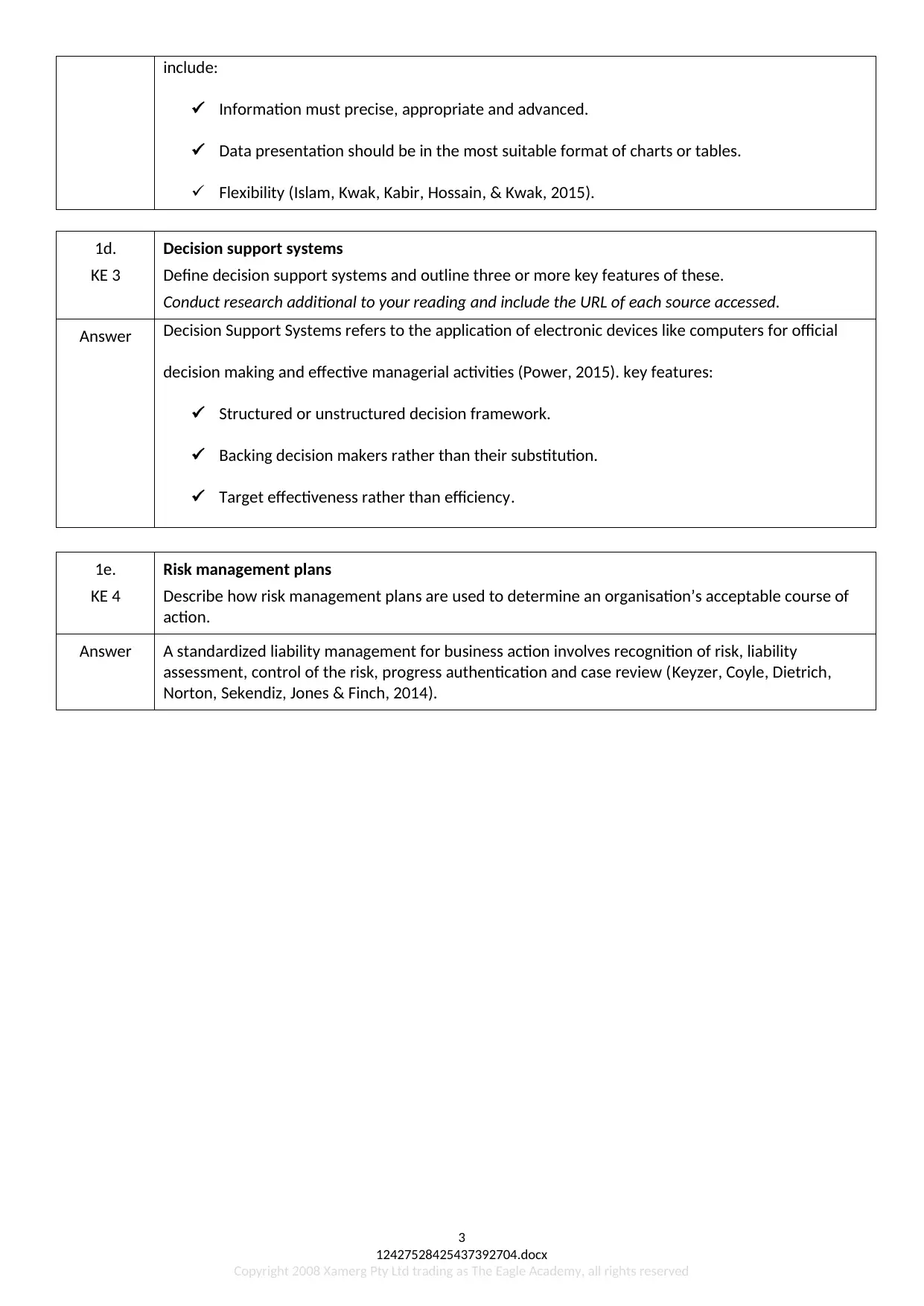
include:
Information must precise, appropriate and advanced.
Data presentation should be in the most suitable format of charts or tables.
Flexibility (Islam, Kwak, Kabir, Hossain, & Kwak, 2015).
1d.
KE 3
Decision support systems
Define decision support systems and outline three or more key features of these.
Conduct research additional to your reading and include the URL of each source accessed.
Answer Decision Support Systems refers to the application of electronic devices like computers for official
decision making and effective managerial activities (Power, 2015). key features:
Structured or unstructured decision framework.
Backing decision makers rather than their substitution.
Target effectiveness rather than efficiency.
1e.
KE 4
Risk management plans
Describe how risk management plans are used to determine an organisation’s acceptable course of
action.
Answer A standardized liability management for business action involves recognition of risk, liability
assessment, control of the risk, progress authentication and case review (Keyzer, Coyle, Dietrich,
Norton, Sekendiz, Jones & Finch, 2014).
3
12427528425437392704.docx
Copyright 2008 Xamerg Pty Ltd trading as The Eagle Academy, all rights reserved
Information must precise, appropriate and advanced.
Data presentation should be in the most suitable format of charts or tables.
Flexibility (Islam, Kwak, Kabir, Hossain, & Kwak, 2015).
1d.
KE 3
Decision support systems
Define decision support systems and outline three or more key features of these.
Conduct research additional to your reading and include the URL of each source accessed.
Answer Decision Support Systems refers to the application of electronic devices like computers for official
decision making and effective managerial activities (Power, 2015). key features:
Structured or unstructured decision framework.
Backing decision makers rather than their substitution.
Target effectiveness rather than efficiency.
1e.
KE 4
Risk management plans
Describe how risk management plans are used to determine an organisation’s acceptable course of
action.
Answer A standardized liability management for business action involves recognition of risk, liability
assessment, control of the risk, progress authentication and case review (Keyzer, Coyle, Dietrich,
Norton, Sekendiz, Jones & Finch, 2014).
3
12427528425437392704.docx
Copyright 2008 Xamerg Pty Ltd trading as The Eagle Academy, all rights reserved
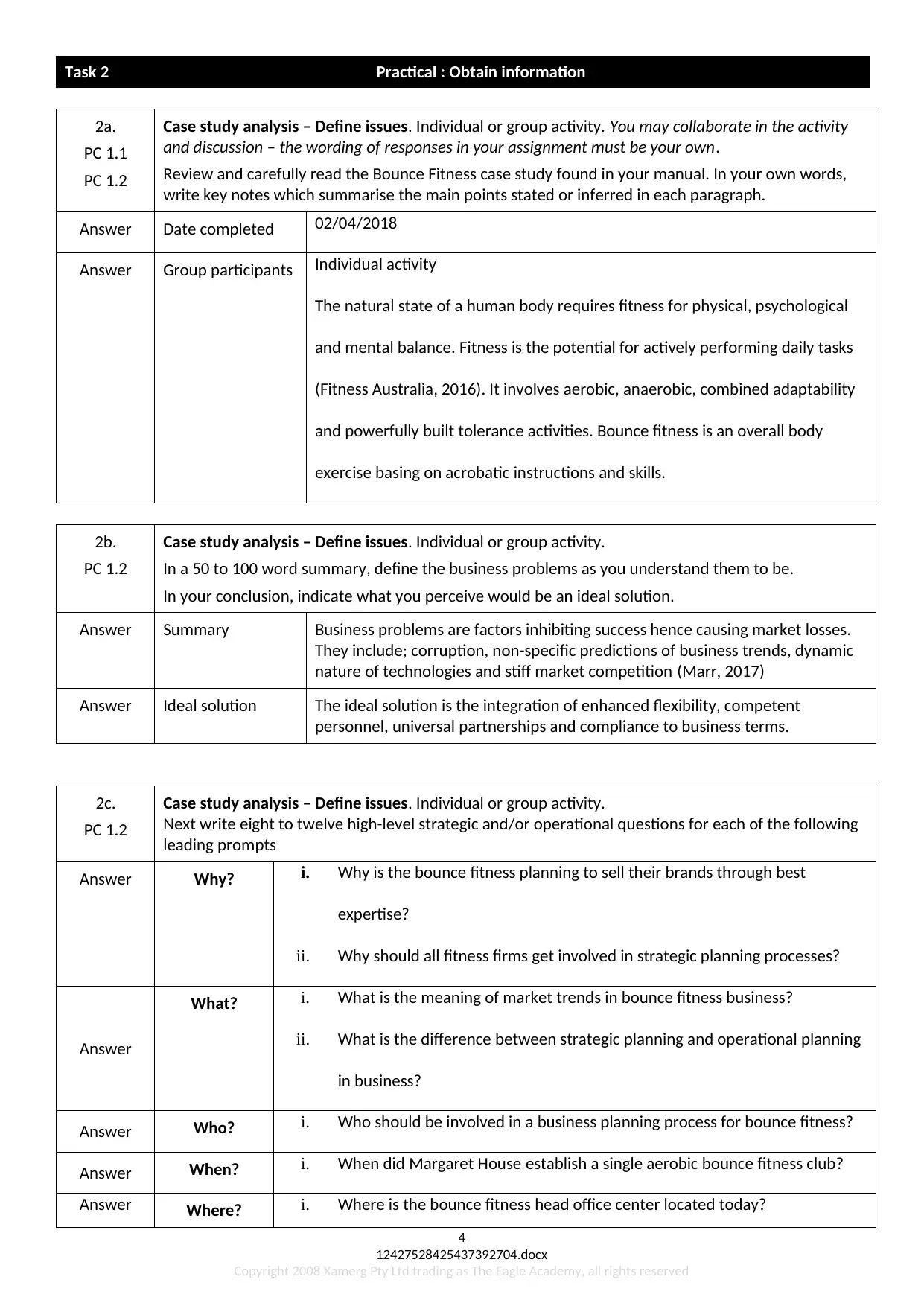
Task 2 Practical : Obtain information
2a.
PC 1.1
PC 1.2
Case study analysis – Define issues. Individual or group activity. You may collaborate in the activity
and discussion – the wording of responses in your assignment must be your own.
Review and carefully read the Bounce Fitness case study found in your manual. In your own words,
write key notes which summarise the main points stated or inferred in each paragraph.
Answer Date completed 02/04/2018
Answer Group participants Individual activity
The natural state of a human body requires fitness for physical, psychological
and mental balance. Fitness is the potential for actively performing daily tasks
(Fitness Australia, 2016). It involves aerobic, anaerobic, combined adaptability
and powerfully built tolerance activities. Bounce fitness is an overall body
exercise basing on acrobatic instructions and skills.
2b.
PC 1.2
Case study analysis – Define issues. Individual or group activity.
In a 50 to 100 word summary, define the business problems as you understand them to be.
In your conclusion, indicate what you perceive would be an ideal solution.
Answer Summary Business problems are factors inhibiting success hence causing market losses.
They include; corruption, non-specific predictions of business trends, dynamic
nature of technologies and stiff market competition (Marr, 2017)
Answer Ideal solution The ideal solution is the integration of enhanced flexibility, competent
personnel, universal partnerships and compliance to business terms.
2c.
PC 1.2
Case study analysis – Define issues. Individual or group activity.
Next write eight to twelve high-level strategic and/or operational questions for each of the following
leading prompts
Answer Why? i. Why is the bounce fitness planning to sell their brands through best
expertise?
ii. Why should all fitness firms get involved in strategic planning processes?
Answer
What? i. What is the meaning of market trends in bounce fitness business?
ii. What is the difference between strategic planning and operational planning
in business?
Answer Who? i. Who should be involved in a business planning process for bounce fitness?
Answer When? i. When did Margaret House establish a single aerobic bounce fitness club?
Answer Where? i. Where is the bounce fitness head office center located today?
4
12427528425437392704.docx
Copyright 2008 Xamerg Pty Ltd trading as The Eagle Academy, all rights reserved
2a.
PC 1.1
PC 1.2
Case study analysis – Define issues. Individual or group activity. You may collaborate in the activity
and discussion – the wording of responses in your assignment must be your own.
Review and carefully read the Bounce Fitness case study found in your manual. In your own words,
write key notes which summarise the main points stated or inferred in each paragraph.
Answer Date completed 02/04/2018
Answer Group participants Individual activity
The natural state of a human body requires fitness for physical, psychological
and mental balance. Fitness is the potential for actively performing daily tasks
(Fitness Australia, 2016). It involves aerobic, anaerobic, combined adaptability
and powerfully built tolerance activities. Bounce fitness is an overall body
exercise basing on acrobatic instructions and skills.
2b.
PC 1.2
Case study analysis – Define issues. Individual or group activity.
In a 50 to 100 word summary, define the business problems as you understand them to be.
In your conclusion, indicate what you perceive would be an ideal solution.
Answer Summary Business problems are factors inhibiting success hence causing market losses.
They include; corruption, non-specific predictions of business trends, dynamic
nature of technologies and stiff market competition (Marr, 2017)
Answer Ideal solution The ideal solution is the integration of enhanced flexibility, competent
personnel, universal partnerships and compliance to business terms.
2c.
PC 1.2
Case study analysis – Define issues. Individual or group activity.
Next write eight to twelve high-level strategic and/or operational questions for each of the following
leading prompts
Answer Why? i. Why is the bounce fitness planning to sell their brands through best
expertise?
ii. Why should all fitness firms get involved in strategic planning processes?
Answer
What? i. What is the meaning of market trends in bounce fitness business?
ii. What is the difference between strategic planning and operational planning
in business?
Answer Who? i. Who should be involved in a business planning process for bounce fitness?
Answer When? i. When did Margaret House establish a single aerobic bounce fitness club?
Answer Where? i. Where is the bounce fitness head office center located today?
4
12427528425437392704.docx
Copyright 2008 Xamerg Pty Ltd trading as The Eagle Academy, all rights reserved
Secure Best Marks with AI Grader
Need help grading? Try our AI Grader for instant feedback on your assignments.
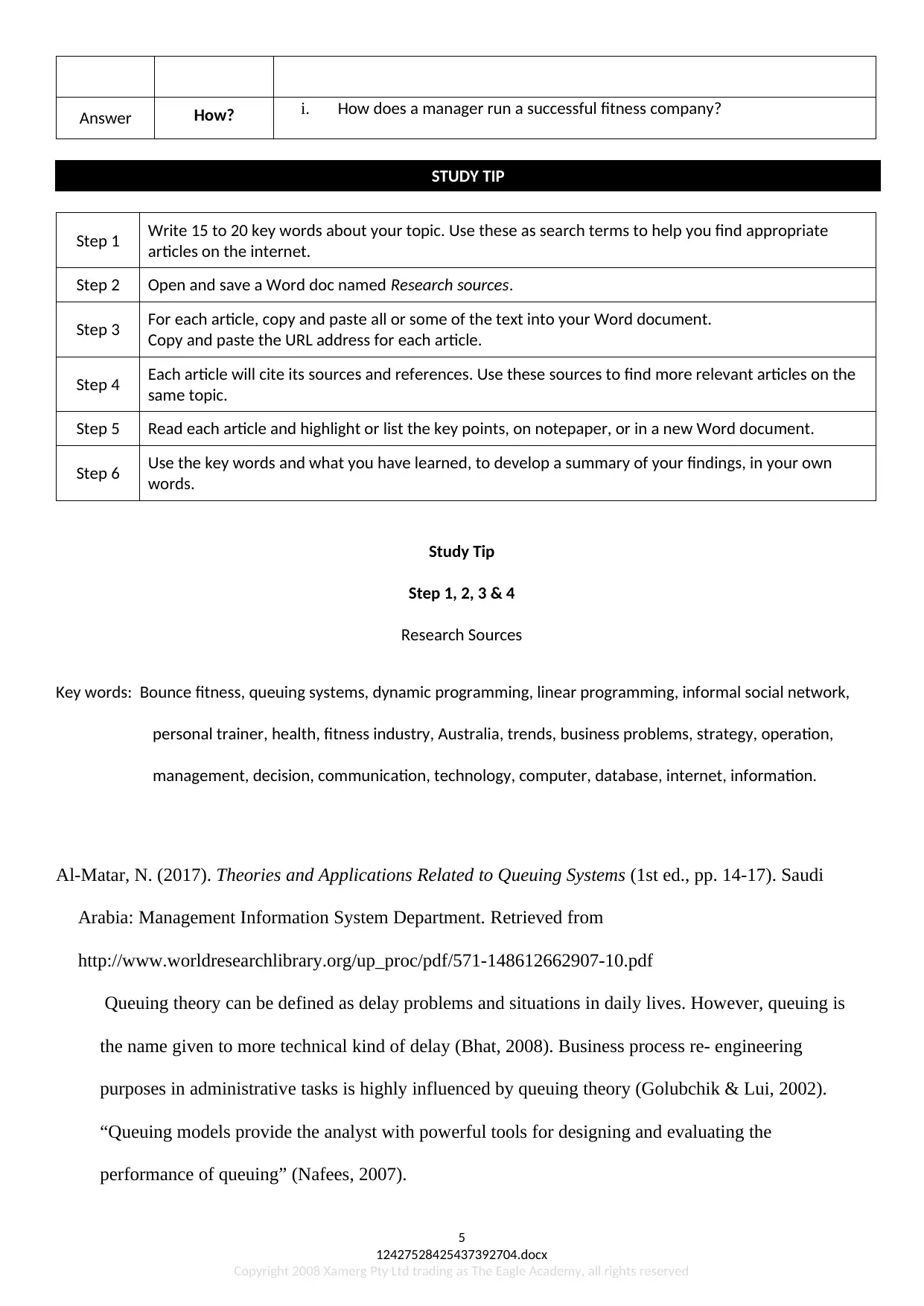
Answer How? i. How does a manager run a successful fitness company?
STUDY TIP
Step 1 Write 15 to 20 key words about your topic. Use these as search terms to help you find appropriate
articles on the internet.
Step 2 Open and save a Word doc named Research sources.
Step 3 For each article, copy and paste all or some of the text into your Word document.
Copy and paste the URL address for each article.
Step 4 Each article will cite its sources and references. Use these sources to find more relevant articles on the
same topic.
Step 5 Read each article and highlight or list the key points, on notepaper, or in a new Word document.
Step 6 Use the key words and what you have learned, to develop a summary of your findings, in your own
words.
Study Tip
Step 1, 2, 3 & 4
Research Sources
Key words: Bounce fitness, queuing systems, dynamic programming, linear programming, informal social network,
personal trainer, health, fitness industry, Australia, trends, business problems, strategy, operation,
management, decision, communication, technology, computer, database, internet, information.
Al-Matar, N. (2017). Theories and Applications Related to Queuing Systems (1st ed., pp. 14-17). Saudi
Arabia: Management Information System Department. Retrieved from
http://www.worldresearchlibrary.org/up_proc/pdf/571-148612662907-10.pdf
Queuing theory can be defined as delay problems and situations in daily lives. However, queuing is
the name given to more technical kind of delay (Bhat, 2008). Business process re- engineering
purposes in administrative tasks is highly influenced by queuing theory (Golubchik & Lui, 2002).
“Queuing models provide the analyst with powerful tools for designing and evaluating the
performance of queuing” (Nafees, 2007).
5
12427528425437392704.docx
Copyright 2008 Xamerg Pty Ltd trading as The Eagle Academy, all rights reserved
STUDY TIP
Step 1 Write 15 to 20 key words about your topic. Use these as search terms to help you find appropriate
articles on the internet.
Step 2 Open and save a Word doc named Research sources.
Step 3 For each article, copy and paste all or some of the text into your Word document.
Copy and paste the URL address for each article.
Step 4 Each article will cite its sources and references. Use these sources to find more relevant articles on the
same topic.
Step 5 Read each article and highlight or list the key points, on notepaper, or in a new Word document.
Step 6 Use the key words and what you have learned, to develop a summary of your findings, in your own
words.
Study Tip
Step 1, 2, 3 & 4
Research Sources
Key words: Bounce fitness, queuing systems, dynamic programming, linear programming, informal social network,
personal trainer, health, fitness industry, Australia, trends, business problems, strategy, operation,
management, decision, communication, technology, computer, database, internet, information.
Al-Matar, N. (2017). Theories and Applications Related to Queuing Systems (1st ed., pp. 14-17). Saudi
Arabia: Management Information System Department. Retrieved from
http://www.worldresearchlibrary.org/up_proc/pdf/571-148612662907-10.pdf
Queuing theory can be defined as delay problems and situations in daily lives. However, queuing is
the name given to more technical kind of delay (Bhat, 2008). Business process re- engineering
purposes in administrative tasks is highly influenced by queuing theory (Golubchik & Lui, 2002).
“Queuing models provide the analyst with powerful tools for designing and evaluating the
performance of queuing” (Nafees, 2007).
5
12427528425437392704.docx
Copyright 2008 Xamerg Pty Ltd trading as The Eagle Academy, all rights reserved
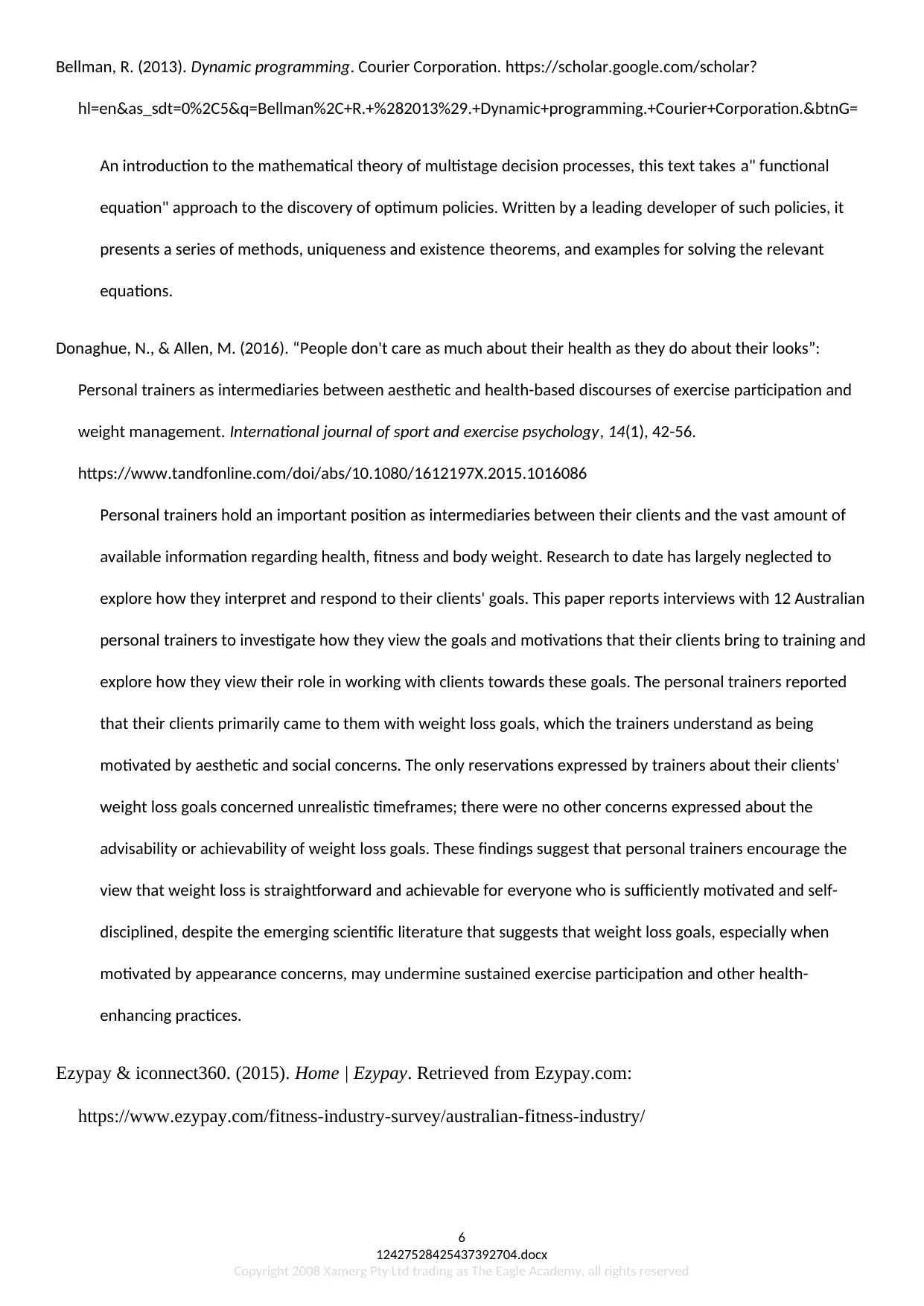
Bellman, R. (2013). Dynamic programming. Courier Corporation. https://scholar.google.com/scholar?
hl=en&as_sdt=0%2C5&q=Bellman%2C+R.+%282013%29.+Dynamic+programming.+Courier+Corporation.&btnG=
An introduction to the mathematical theory of multistage decision processes, this text takes a" functional
equation" approach to the discovery of optimum policies. Written by a leading developer of such policies, it
presents a series of methods, uniqueness and existence theorems, and examples for solving the relevant
equations.
Donaghue, N., & Allen, M. (2016). “People don't care as much about their health as they do about their looks”:
Personal trainers as intermediaries between aesthetic and health-based discourses of exercise participation and
weight management. International journal of sport and exercise psychology, 14(1), 42-56.
https://www.tandfonline.com/doi/abs/10.1080/1612197X.2015.1016086
Personal trainers hold an important position as intermediaries between their clients and the vast amount of
available information regarding health, fitness and body weight. Research to date has largely neglected to
explore how they interpret and respond to their clients' goals. This paper reports interviews with 12 Australian
personal trainers to investigate how they view the goals and motivations that their clients bring to training and
explore how they view their role in working with clients towards these goals. The personal trainers reported
that their clients primarily came to them with weight loss goals, which the trainers understand as being
motivated by aesthetic and social concerns. The only reservations expressed by trainers about their clients'
weight loss goals concerned unrealistic timeframes; there were no other concerns expressed about the
advisability or achievability of weight loss goals. These findings suggest that personal trainers encourage the
view that weight loss is straightforward and achievable for everyone who is sufficiently motivated and self-
disciplined, despite the emerging scientific literature that suggests that weight loss goals, especially when
motivated by appearance concerns, may undermine sustained exercise participation and other health-
enhancing practices.
Ezypay & iconnect360. (2015). Home | Ezypay. Retrieved from Ezypay.com:
https://www.ezypay.com/fitness-industry-survey/australian-fitness-industry/
6
12427528425437392704.docx
Copyright 2008 Xamerg Pty Ltd trading as The Eagle Academy, all rights reserved
hl=en&as_sdt=0%2C5&q=Bellman%2C+R.+%282013%29.+Dynamic+programming.+Courier+Corporation.&btnG=
An introduction to the mathematical theory of multistage decision processes, this text takes a" functional
equation" approach to the discovery of optimum policies. Written by a leading developer of such policies, it
presents a series of methods, uniqueness and existence theorems, and examples for solving the relevant
equations.
Donaghue, N., & Allen, M. (2016). “People don't care as much about their health as they do about their looks”:
Personal trainers as intermediaries between aesthetic and health-based discourses of exercise participation and
weight management. International journal of sport and exercise psychology, 14(1), 42-56.
https://www.tandfonline.com/doi/abs/10.1080/1612197X.2015.1016086
Personal trainers hold an important position as intermediaries between their clients and the vast amount of
available information regarding health, fitness and body weight. Research to date has largely neglected to
explore how they interpret and respond to their clients' goals. This paper reports interviews with 12 Australian
personal trainers to investigate how they view the goals and motivations that their clients bring to training and
explore how they view their role in working with clients towards these goals. The personal trainers reported
that their clients primarily came to them with weight loss goals, which the trainers understand as being
motivated by aesthetic and social concerns. The only reservations expressed by trainers about their clients'
weight loss goals concerned unrealistic timeframes; there were no other concerns expressed about the
advisability or achievability of weight loss goals. These findings suggest that personal trainers encourage the
view that weight loss is straightforward and achievable for everyone who is sufficiently motivated and self-
disciplined, despite the emerging scientific literature that suggests that weight loss goals, especially when
motivated by appearance concerns, may undermine sustained exercise participation and other health-
enhancing practices.
Ezypay & iconnect360. (2015). Home | Ezypay. Retrieved from Ezypay.com:
https://www.ezypay.com/fitness-industry-survey/australian-fitness-industry/
6
12427528425437392704.docx
Copyright 2008 Xamerg Pty Ltd trading as The Eagle Academy, all rights reserved
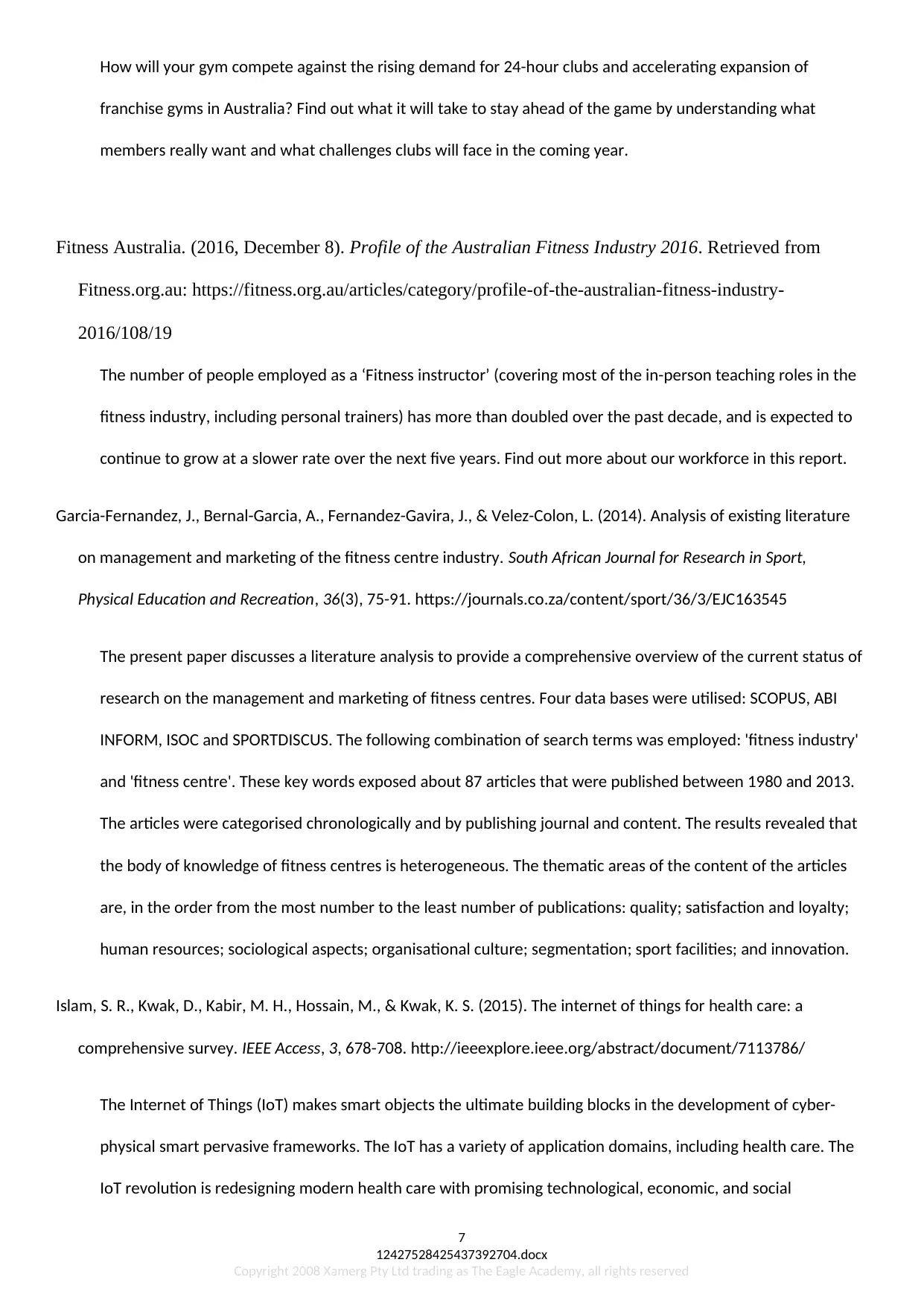
How will your gym compete against the rising demand for 24-hour clubs and accelerating expansion of
franchise gyms in Australia? Find out what it will take to stay ahead of the game by understanding what
members really want and what challenges clubs will face in the coming year.
Fitness Australia. (2016, December 8). Profile of the Australian Fitness Industry 2016. Retrieved from
Fitness.org.au: https://fitness.org.au/articles/category/profile-of-the-australian-fitness-industry-
2016/108/19
The number of people employed as a ‘Fitness instructor’ (covering most of the in-person teaching roles in the
fitness industry, including personal trainers) has more than doubled over the past decade, and is expected to
continue to grow at a slower rate over the next five years. Find out more about our workforce in this report.
Garcia-Fernandez, J., Bernal-Garcia, A., Fernandez-Gavira, J., & Velez-Colon, L. (2014). Analysis of existing literature
on management and marketing of the fitness centre industry. South African Journal for Research in Sport,
Physical Education and Recreation, 36(3), 75-91. https://journals.co.za/content/sport/36/3/EJC163545
The present paper discusses a literature analysis to provide a comprehensive overview of the current status of
research on the management and marketing of fitness centres. Four data bases were utilised: SCOPUS, ABI
INFORM, ISOC and SPORTDISCUS. The following combination of search terms was employed: 'fitness industry'
and 'fitness centre'. These key words exposed about 87 articles that were published between 1980 and 2013.
The articles were categorised chronologically and by publishing journal and content. The results revealed that
the body of knowledge of fitness centres is heterogeneous. The thematic areas of the content of the articles
are, in the order from the most number to the least number of publications: quality; satisfaction and loyalty;
human resources; sociological aspects; organisational culture; segmentation; sport facilities; and innovation.
Islam, S. R., Kwak, D., Kabir, M. H., Hossain, M., & Kwak, K. S. (2015). The internet of things for health care: a
comprehensive survey. IEEE Access, 3, 678-708. http://ieeexplore.ieee.org/abstract/document/7113786/
The Internet of Things (IoT) makes smart objects the ultimate building blocks in the development of cyber-
physical smart pervasive frameworks. The IoT has a variety of application domains, including health care. The
IoT revolution is redesigning modern health care with promising technological, economic, and social
7
12427528425437392704.docx
Copyright 2008 Xamerg Pty Ltd trading as The Eagle Academy, all rights reserved
franchise gyms in Australia? Find out what it will take to stay ahead of the game by understanding what
members really want and what challenges clubs will face in the coming year.
Fitness Australia. (2016, December 8). Profile of the Australian Fitness Industry 2016. Retrieved from
Fitness.org.au: https://fitness.org.au/articles/category/profile-of-the-australian-fitness-industry-
2016/108/19
The number of people employed as a ‘Fitness instructor’ (covering most of the in-person teaching roles in the
fitness industry, including personal trainers) has more than doubled over the past decade, and is expected to
continue to grow at a slower rate over the next five years. Find out more about our workforce in this report.
Garcia-Fernandez, J., Bernal-Garcia, A., Fernandez-Gavira, J., & Velez-Colon, L. (2014). Analysis of existing literature
on management and marketing of the fitness centre industry. South African Journal for Research in Sport,
Physical Education and Recreation, 36(3), 75-91. https://journals.co.za/content/sport/36/3/EJC163545
The present paper discusses a literature analysis to provide a comprehensive overview of the current status of
research on the management and marketing of fitness centres. Four data bases were utilised: SCOPUS, ABI
INFORM, ISOC and SPORTDISCUS. The following combination of search terms was employed: 'fitness industry'
and 'fitness centre'. These key words exposed about 87 articles that were published between 1980 and 2013.
The articles were categorised chronologically and by publishing journal and content. The results revealed that
the body of knowledge of fitness centres is heterogeneous. The thematic areas of the content of the articles
are, in the order from the most number to the least number of publications: quality; satisfaction and loyalty;
human resources; sociological aspects; organisational culture; segmentation; sport facilities; and innovation.
Islam, S. R., Kwak, D., Kabir, M. H., Hossain, M., & Kwak, K. S. (2015). The internet of things for health care: a
comprehensive survey. IEEE Access, 3, 678-708. http://ieeexplore.ieee.org/abstract/document/7113786/
The Internet of Things (IoT) makes smart objects the ultimate building blocks in the development of cyber-
physical smart pervasive frameworks. The IoT has a variety of application domains, including health care. The
IoT revolution is redesigning modern health care with promising technological, economic, and social
7
12427528425437392704.docx
Copyright 2008 Xamerg Pty Ltd trading as The Eagle Academy, all rights reserved
Paraphrase This Document
Need a fresh take? Get an instant paraphrase of this document with our AI Paraphraser

prospects. This paper surveys advances in IoT-based health care technologies and reviews the state-of-the-art
network architectures/platforms, applications, and industrial trends in IoT-based health care solutions. In
addition, this paper analyses distinct IoT security and privacy features, including security requirements, threat
models, and attack taxonomies from the health care perspective
Jansen, R. J., Curşeu, P. L., Vermeulen, P. A., Geurts, J. L., & Gibcus, P. (2013). Information processing and strategic
decision-making in small and medium-sized enterprises: The role of human and social capital in attaining decision
effectiveness. International small business journal, 31(2), 192-216.
http://journals.sagepub.com/doi/abs/10.1177/0266242611406762
The decision-making literature emphasizes that in high-stake decisions the characteristics of individual
decision-makers, their interpretation of decision situations, and their social ties play an important role in
decision outcomes. Despite these results, research on small- and medium-sized enterprises has only partially
covered these influences. In a sample of 565 small-business owners, this study identifies the extent to which
these characteristics and social ties affect decision effectiveness and the extent to which their impact is
mediated by evaluative judgements of the decision situation. Our results suggest that the interplay between
human capital and social capital affects decision outcomes via evaluative judgments and this effect is
moderated by decision content, in such a way that depending on decision content (internal versus external
focus) entrepreneurial experience and the breadth of social capital are either assets or liabilities for decision
effectiveness.
Kearney, A. T. (2017, September). White paper on technology and innovation for the future of production:
accelerating value creation. In World Economic Forum. Accessed (Vol. 28).
www3.weforum.org/.../WEF_White_Paper_Technology_Innovation_Future_of_Prod...
Business leaders and policy-makers must keep track of more than 60 technologies and philosophies impacting
production systems today (see Figure 1). These technologies are obliging companies to rethink and retool
everything they do internally, and governments to reassess their national competitive advantages and
development strategies. The chief executives and chief operating officers who embrace these technologies
and rapidly transform their enterprises will set their companies on course for success.
8
12427528425437392704.docx
Copyright 2008 Xamerg Pty Ltd trading as The Eagle Academy, all rights reserved
network architectures/platforms, applications, and industrial trends in IoT-based health care solutions. In
addition, this paper analyses distinct IoT security and privacy features, including security requirements, threat
models, and attack taxonomies from the health care perspective
Jansen, R. J., Curşeu, P. L., Vermeulen, P. A., Geurts, J. L., & Gibcus, P. (2013). Information processing and strategic
decision-making in small and medium-sized enterprises: The role of human and social capital in attaining decision
effectiveness. International small business journal, 31(2), 192-216.
http://journals.sagepub.com/doi/abs/10.1177/0266242611406762
The decision-making literature emphasizes that in high-stake decisions the characteristics of individual
decision-makers, their interpretation of decision situations, and their social ties play an important role in
decision outcomes. Despite these results, research on small- and medium-sized enterprises has only partially
covered these influences. In a sample of 565 small-business owners, this study identifies the extent to which
these characteristics and social ties affect decision effectiveness and the extent to which their impact is
mediated by evaluative judgements of the decision situation. Our results suggest that the interplay between
human capital and social capital affects decision outcomes via evaluative judgments and this effect is
moderated by decision content, in such a way that depending on decision content (internal versus external
focus) entrepreneurial experience and the breadth of social capital are either assets or liabilities for decision
effectiveness.
Kearney, A. T. (2017, September). White paper on technology and innovation for the future of production:
accelerating value creation. In World Economic Forum. Accessed (Vol. 28).
www3.weforum.org/.../WEF_White_Paper_Technology_Innovation_Future_of_Prod...
Business leaders and policy-makers must keep track of more than 60 technologies and philosophies impacting
production systems today (see Figure 1). These technologies are obliging companies to rethink and retool
everything they do internally, and governments to reassess their national competitive advantages and
development strategies. The chief executives and chief operating officers who embrace these technologies
and rapidly transform their enterprises will set their companies on course for success.
8
12427528425437392704.docx
Copyright 2008 Xamerg Pty Ltd trading as The Eagle Academy, all rights reserved
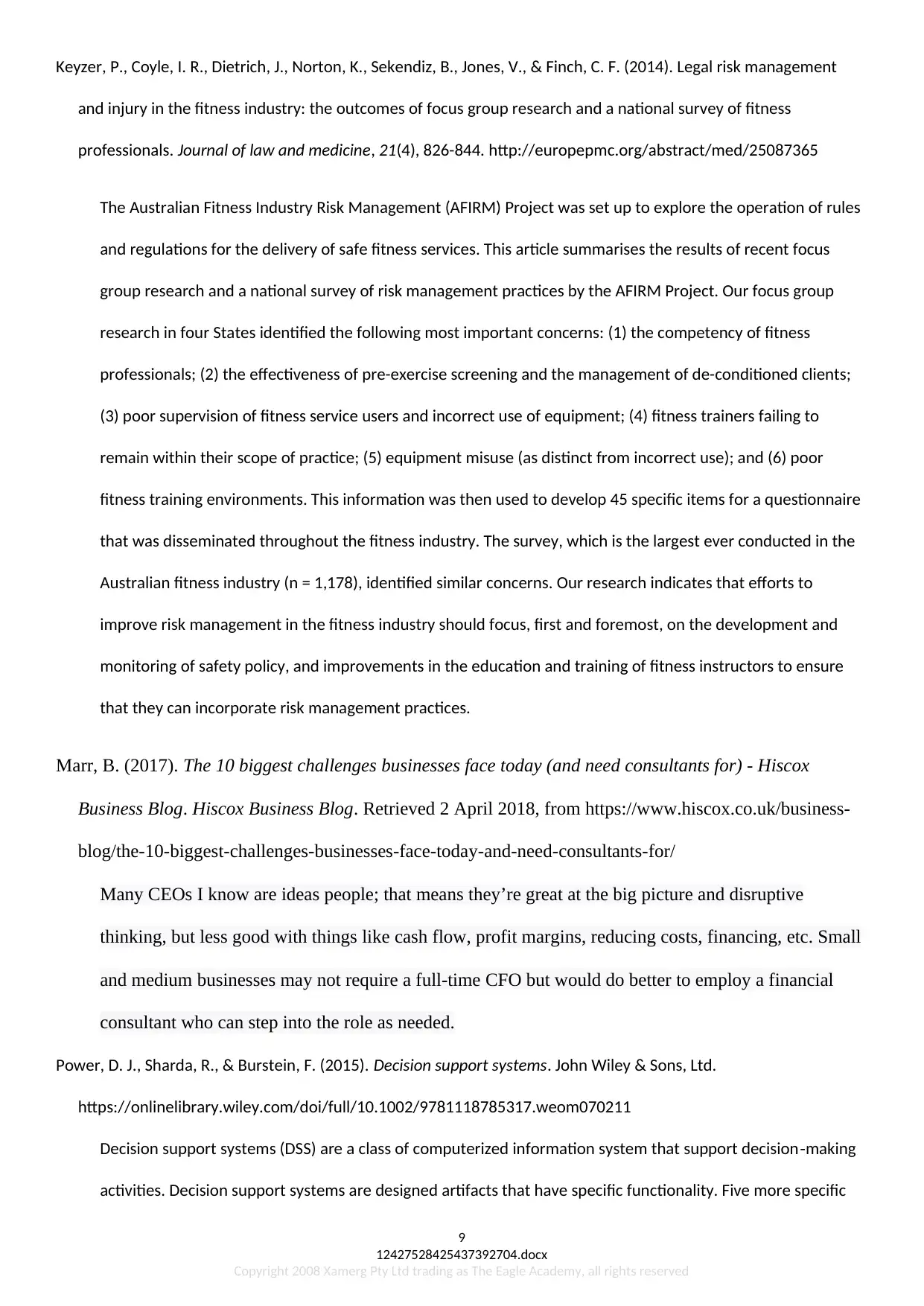
Keyzer, P., Coyle, I. R., Dietrich, J., Norton, K., Sekendiz, B., Jones, V., & Finch, C. F. (2014). Legal risk management
and injury in the fitness industry: the outcomes of focus group research and a national survey of fitness
professionals. Journal of law and medicine, 21(4), 826-844. http://europepmc.org/abstract/med/25087365
The Australian Fitness Industry Risk Management (AFIRM) Project was set up to explore the operation of rules
and regulations for the delivery of safe fitness services. This article summarises the results of recent focus
group research and a national survey of risk management practices by the AFIRM Project. Our focus group
research in four States identified the following most important concerns: (1) the competency of fitness
professionals; (2) the effectiveness of pre-exercise screening and the management of de-conditioned clients;
(3) poor supervision of fitness service users and incorrect use of equipment; (4) fitness trainers failing to
remain within their scope of practice; (5) equipment misuse (as distinct from incorrect use); and (6) poor
fitness training environments. This information was then used to develop 45 specific items for a questionnaire
that was disseminated throughout the fitness industry. The survey, which is the largest ever conducted in the
Australian fitness industry (n = 1,178), identified similar concerns. Our research indicates that efforts to
improve risk management in the fitness industry should focus, first and foremost, on the development and
monitoring of safety policy, and improvements in the education and training of fitness instructors to ensure
that they can incorporate risk management practices.
Marr, B. (2017). The 10 biggest challenges businesses face today (and need consultants for) - Hiscox
Business Blog. Hiscox Business Blog. Retrieved 2 April 2018, from https://www.hiscox.co.uk/business-
blog/the-10-biggest-challenges-businesses-face-today-and-need-consultants-for/
Many CEOs I know are ideas people; that means they’re great at the big picture and disruptive
thinking, but less good with things like cash flow, profit margins, reducing costs, financing, etc. Small
and medium businesses may not require a full-time CFO but would do better to employ a financial
consultant who can step into the role as needed.
Power, D. J., Sharda, R., & Burstein, F. (2015). Decision support systems. John Wiley & Sons, Ltd.
https://onlinelibrary.wiley.com/doi/full/10.1002/9781118785317.weom070211
Decision support systems (DSS) are a class of computerized information system that support decision‐making
activities. Decision support systems are designed artifacts that have specific functionality. Five more specific
9
12427528425437392704.docx
Copyright 2008 Xamerg Pty Ltd trading as The Eagle Academy, all rights reserved
and injury in the fitness industry: the outcomes of focus group research and a national survey of fitness
professionals. Journal of law and medicine, 21(4), 826-844. http://europepmc.org/abstract/med/25087365
The Australian Fitness Industry Risk Management (AFIRM) Project was set up to explore the operation of rules
and regulations for the delivery of safe fitness services. This article summarises the results of recent focus
group research and a national survey of risk management practices by the AFIRM Project. Our focus group
research in four States identified the following most important concerns: (1) the competency of fitness
professionals; (2) the effectiveness of pre-exercise screening and the management of de-conditioned clients;
(3) poor supervision of fitness service users and incorrect use of equipment; (4) fitness trainers failing to
remain within their scope of practice; (5) equipment misuse (as distinct from incorrect use); and (6) poor
fitness training environments. This information was then used to develop 45 specific items for a questionnaire
that was disseminated throughout the fitness industry. The survey, which is the largest ever conducted in the
Australian fitness industry (n = 1,178), identified similar concerns. Our research indicates that efforts to
improve risk management in the fitness industry should focus, first and foremost, on the development and
monitoring of safety policy, and improvements in the education and training of fitness instructors to ensure
that they can incorporate risk management practices.
Marr, B. (2017). The 10 biggest challenges businesses face today (and need consultants for) - Hiscox
Business Blog. Hiscox Business Blog. Retrieved 2 April 2018, from https://www.hiscox.co.uk/business-
blog/the-10-biggest-challenges-businesses-face-today-and-need-consultants-for/
Many CEOs I know are ideas people; that means they’re great at the big picture and disruptive
thinking, but less good with things like cash flow, profit margins, reducing costs, financing, etc. Small
and medium businesses may not require a full-time CFO but would do better to employ a financial
consultant who can step into the role as needed.
Power, D. J., Sharda, R., & Burstein, F. (2015). Decision support systems. John Wiley & Sons, Ltd.
https://onlinelibrary.wiley.com/doi/full/10.1002/9781118785317.weom070211
Decision support systems (DSS) are a class of computerized information system that support decision‐making
activities. Decision support systems are designed artifacts that have specific functionality. Five more specific
9
12427528425437392704.docx
Copyright 2008 Xamerg Pty Ltd trading as The Eagle Academy, all rights reserved
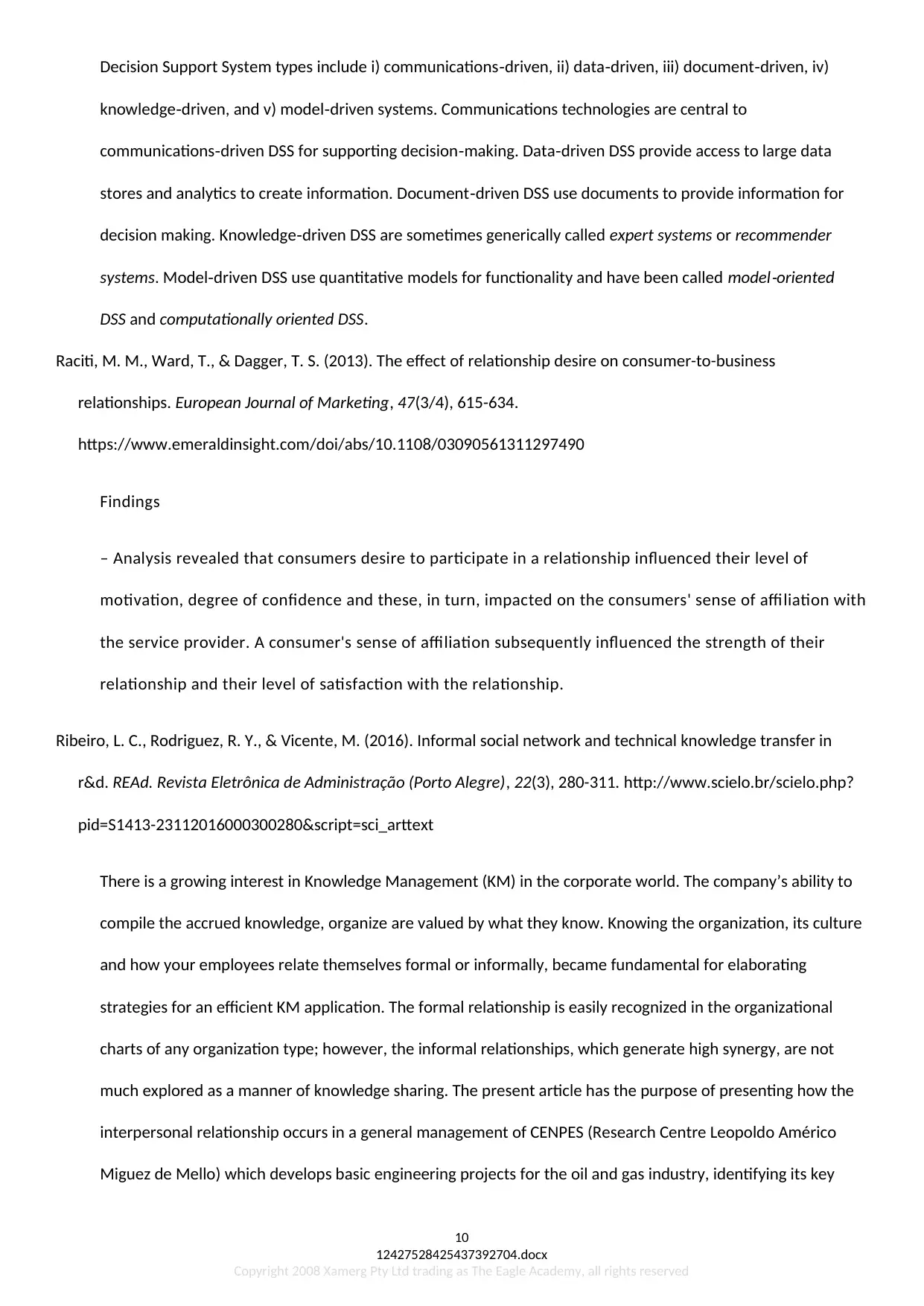
Decision Support System types include i) communications‐driven, ii) data‐driven, iii) document‐driven, iv)
knowledge‐driven, and v) model‐driven systems. Communications technologies are central to
communications‐driven DSS for supporting decision‐making. Data‐driven DSS provide access to large data
stores and analytics to create information. Document‐driven DSS use documents to provide information for
decision making. Knowledge‐driven DSS are sometimes generically called expert systems or recommender
systems. Model‐driven DSS use quantitative models for functionality and have been called model
‐oriented
DSS and computationally oriented DSS.
Raciti, M. M., Ward, T., & Dagger, T. S. (2013). The effect of relationship desire on consumer-to-business
relationships. European Journal of Marketing, 47(3/4), 615-634.
https://www.emeraldinsight.com/doi/abs/10.1108/03090561311297490
Findings
– Analysis revealed that consumers desire to participate in a relationship influenced their level of
motivation, degree of confidence and these, in turn, impacted on the consumers' sense of affiliation with
the service provider. A consumer's sense of affiliation subsequently influenced the strength of their
relationship and their level of satisfaction with the relationship.
Ribeiro, L. C., Rodriguez, R. Y., & Vicente, M. (2016). Informal social network and technical knowledge transfer in
r&d. REAd. Revista Eletrônica de Administração (Porto Alegre), 22(3), 280-311. http://www.scielo.br/scielo.php?
pid=S1413-23112016000300280&script=sci_arttext
There is a growing interest in Knowledge Management (KM) in the corporate world. The company’s ability to
compile the accrued knowledge, organize are valued by what they know. Knowing the organization, its culture
and how your employees relate themselves formal or informally, became fundamental for elaborating
strategies for an efficient KM application. The formal relationship is easily recognized in the organizational
charts of any organization type; however, the informal relationships, which generate high synergy, are not
much explored as a manner of knowledge sharing. The present article has the purpose of presenting how the
interpersonal relationship occurs in a general management of CENPES (Research Centre Leopoldo Américo
Miguez de Mello) which develops basic engineering projects for the oil and gas industry, identifying its key
10
12427528425437392704.docx
Copyright 2008 Xamerg Pty Ltd trading as The Eagle Academy, all rights reserved
knowledge‐driven, and v) model‐driven systems. Communications technologies are central to
communications‐driven DSS for supporting decision‐making. Data‐driven DSS provide access to large data
stores and analytics to create information. Document‐driven DSS use documents to provide information for
decision making. Knowledge‐driven DSS are sometimes generically called expert systems or recommender
systems. Model‐driven DSS use quantitative models for functionality and have been called model
‐oriented
DSS and computationally oriented DSS.
Raciti, M. M., Ward, T., & Dagger, T. S. (2013). The effect of relationship desire on consumer-to-business
relationships. European Journal of Marketing, 47(3/4), 615-634.
https://www.emeraldinsight.com/doi/abs/10.1108/03090561311297490
Findings
– Analysis revealed that consumers desire to participate in a relationship influenced their level of
motivation, degree of confidence and these, in turn, impacted on the consumers' sense of affiliation with
the service provider. A consumer's sense of affiliation subsequently influenced the strength of their
relationship and their level of satisfaction with the relationship.
Ribeiro, L. C., Rodriguez, R. Y., & Vicente, M. (2016). Informal social network and technical knowledge transfer in
r&d. REAd. Revista Eletrônica de Administração (Porto Alegre), 22(3), 280-311. http://www.scielo.br/scielo.php?
pid=S1413-23112016000300280&script=sci_arttext
There is a growing interest in Knowledge Management (KM) in the corporate world. The company’s ability to
compile the accrued knowledge, organize are valued by what they know. Knowing the organization, its culture
and how your employees relate themselves formal or informally, became fundamental for elaborating
strategies for an efficient KM application. The formal relationship is easily recognized in the organizational
charts of any organization type; however, the informal relationships, which generate high synergy, are not
much explored as a manner of knowledge sharing. The present article has the purpose of presenting how the
interpersonal relationship occurs in a general management of CENPES (Research Centre Leopoldo Américo
Miguez de Mello) which develops basic engineering projects for the oil and gas industry, identifying its key
10
12427528425437392704.docx
Copyright 2008 Xamerg Pty Ltd trading as The Eagle Academy, all rights reserved
Secure Best Marks with AI Grader
Need help grading? Try our AI Grader for instant feedback on your assignments.
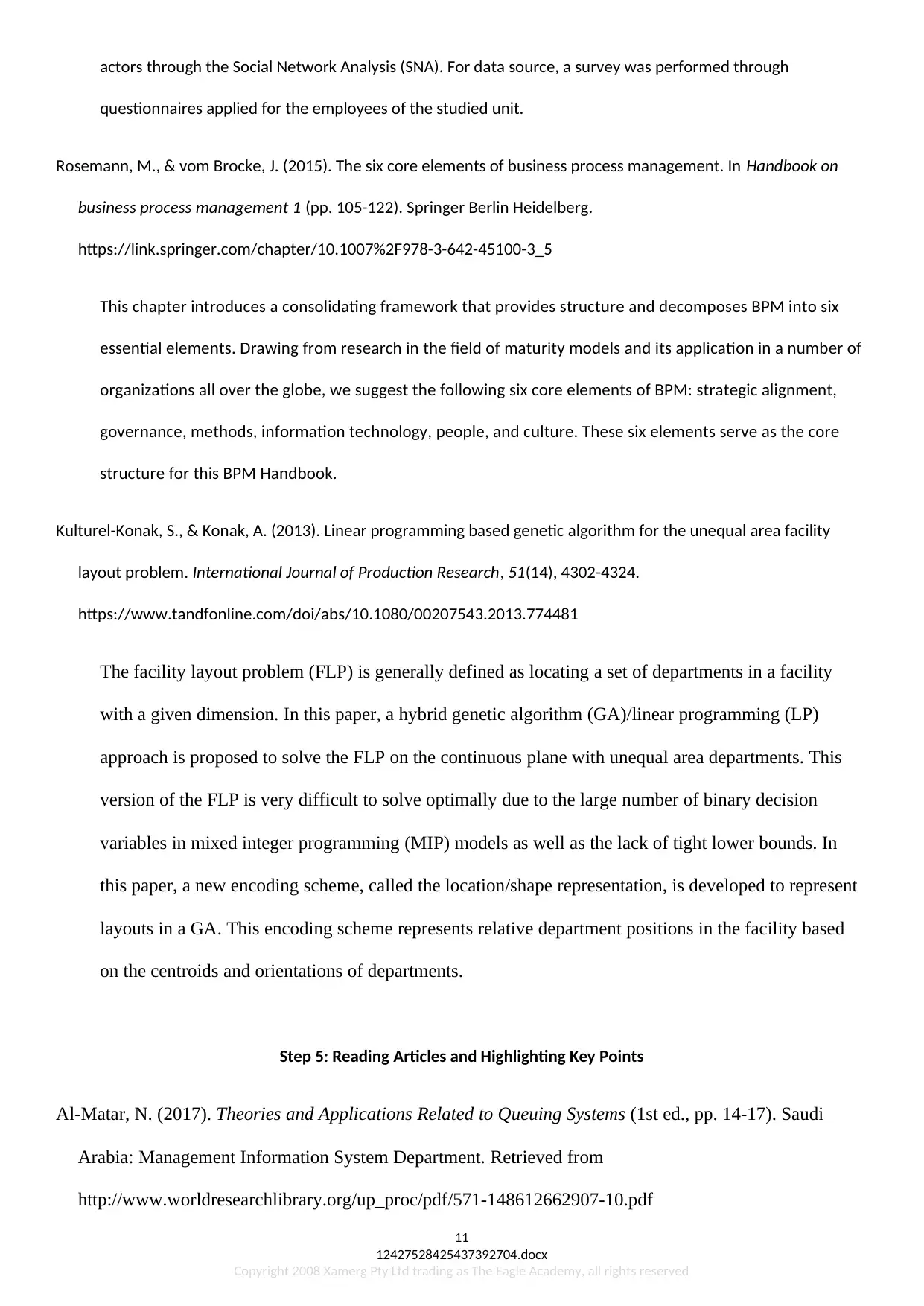
actors through the Social Network Analysis (SNA). For data source, a survey was performed through
questionnaires applied for the employees of the studied unit.
Rosemann, M., & vom Brocke, J. (2015). The six core elements of business process management. In Handbook on
business process management 1 (pp. 105-122). Springer Berlin Heidelberg.
https://link.springer.com/chapter/10.1007%2F978-3-642-45100-3_5
This chapter introduces a consolidating framework that provides structure and decomposes BPM into six
essential elements. Drawing from research in the field of maturity models and its application in a number of
organizations all over the globe, we suggest the following six core elements of BPM: strategic alignment,
governance, methods, information technology, people, and culture. These six elements serve as the core
structure for this BPM Handbook.
Kulturel-Konak, S., & Konak, A. (2013). Linear programming based genetic algorithm for the unequal area facility
layout problem. International Journal of Production Research, 51(14), 4302-4324.
https://www.tandfonline.com/doi/abs/10.1080/00207543.2013.774481
The facility layout problem (FLP) is generally defined as locating a set of departments in a facility
with a given dimension. In this paper, a hybrid genetic algorithm (GA)/linear programming (LP)
approach is proposed to solve the FLP on the continuous plane with unequal area departments. This
version of the FLP is very difficult to solve optimally due to the large number of binary decision
variables in mixed integer programming (MIP) models as well as the lack of tight lower bounds. In
this paper, a new encoding scheme, called the location/shape representation, is developed to represent
layouts in a GA. This encoding scheme represents relative department positions in the facility based
on the centroids and orientations of departments.
Step 5: Reading Articles and Highlighting Key Points
Al-Matar, N. (2017). Theories and Applications Related to Queuing Systems (1st ed., pp. 14-17). Saudi
Arabia: Management Information System Department. Retrieved from
http://www.worldresearchlibrary.org/up_proc/pdf/571-148612662907-10.pdf
11
12427528425437392704.docx
Copyright 2008 Xamerg Pty Ltd trading as The Eagle Academy, all rights reserved
questionnaires applied for the employees of the studied unit.
Rosemann, M., & vom Brocke, J. (2015). The six core elements of business process management. In Handbook on
business process management 1 (pp. 105-122). Springer Berlin Heidelberg.
https://link.springer.com/chapter/10.1007%2F978-3-642-45100-3_5
This chapter introduces a consolidating framework that provides structure and decomposes BPM into six
essential elements. Drawing from research in the field of maturity models and its application in a number of
organizations all over the globe, we suggest the following six core elements of BPM: strategic alignment,
governance, methods, information technology, people, and culture. These six elements serve as the core
structure for this BPM Handbook.
Kulturel-Konak, S., & Konak, A. (2013). Linear programming based genetic algorithm for the unequal area facility
layout problem. International Journal of Production Research, 51(14), 4302-4324.
https://www.tandfonline.com/doi/abs/10.1080/00207543.2013.774481
The facility layout problem (FLP) is generally defined as locating a set of departments in a facility
with a given dimension. In this paper, a hybrid genetic algorithm (GA)/linear programming (LP)
approach is proposed to solve the FLP on the continuous plane with unequal area departments. This
version of the FLP is very difficult to solve optimally due to the large number of binary decision
variables in mixed integer programming (MIP) models as well as the lack of tight lower bounds. In
this paper, a new encoding scheme, called the location/shape representation, is developed to represent
layouts in a GA. This encoding scheme represents relative department positions in the facility based
on the centroids and orientations of departments.
Step 5: Reading Articles and Highlighting Key Points
Al-Matar, N. (2017). Theories and Applications Related to Queuing Systems (1st ed., pp. 14-17). Saudi
Arabia: Management Information System Department. Retrieved from
http://www.worldresearchlibrary.org/up_proc/pdf/571-148612662907-10.pdf
11
12427528425437392704.docx
Copyright 2008 Xamerg Pty Ltd trading as The Eagle Academy, all rights reserved
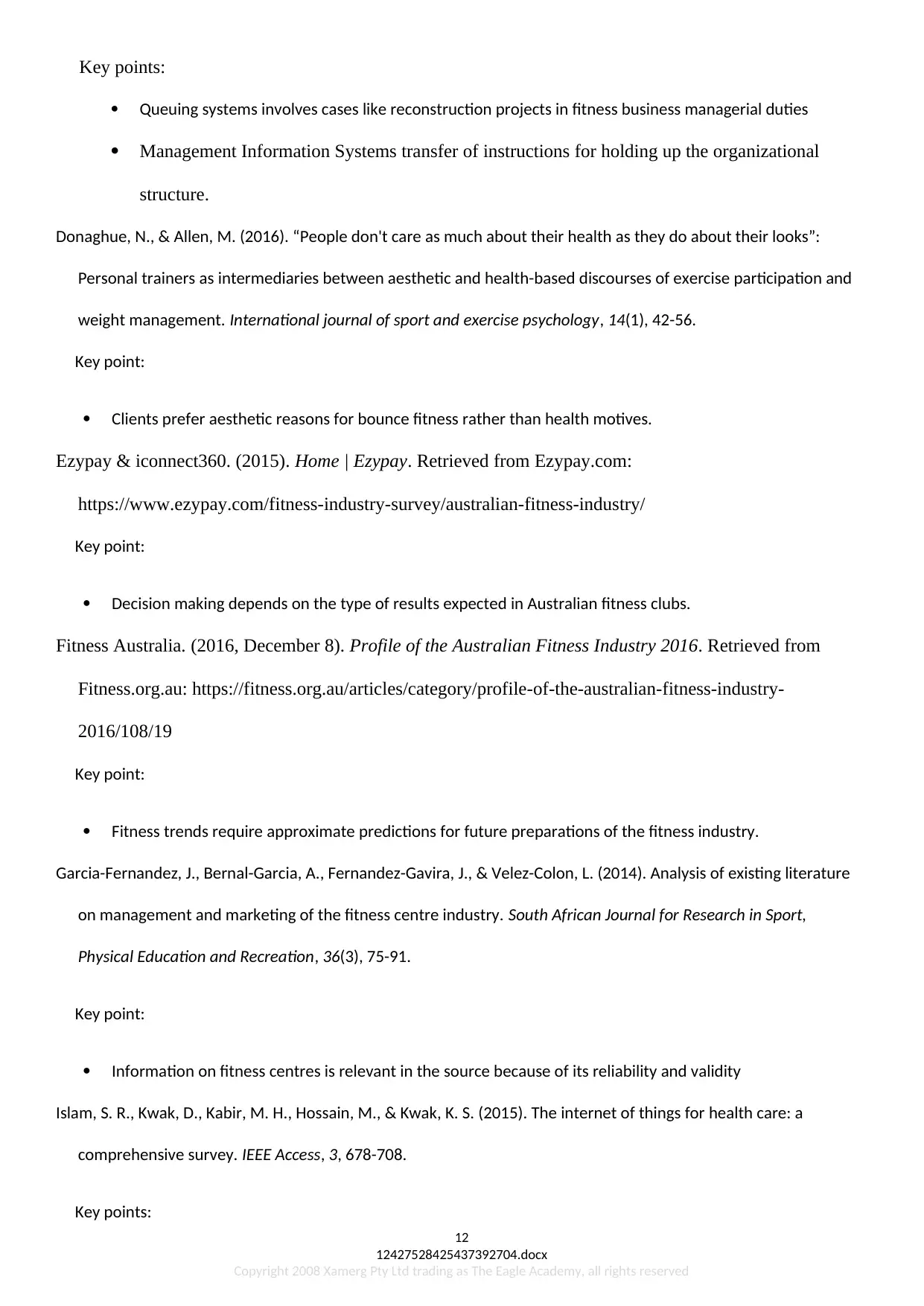
Key points:
Queuing systems involves cases like reconstruction projects in fitness business managerial duties
Management Information Systems transfer of instructions for holding up the organizational
structure.
Donaghue, N., & Allen, M. (2016). “People don't care as much about their health as they do about their looks”:
Personal trainers as intermediaries between aesthetic and health-based discourses of exercise participation and
weight management. International journal of sport and exercise psychology, 14(1), 42-56.
Key point:
Clients prefer aesthetic reasons for bounce fitness rather than health motives.
Ezypay & iconnect360. (2015). Home | Ezypay. Retrieved from Ezypay.com:
https://www.ezypay.com/fitness-industry-survey/australian-fitness-industry/
Key point:
Decision making depends on the type of results expected in Australian fitness clubs.
Fitness Australia. (2016, December 8). Profile of the Australian Fitness Industry 2016. Retrieved from
Fitness.org.au: https://fitness.org.au/articles/category/profile-of-the-australian-fitness-industry-
2016/108/19
Key point:
Fitness trends require approximate predictions for future preparations of the fitness industry.
Garcia-Fernandez, J., Bernal-Garcia, A., Fernandez-Gavira, J., & Velez-Colon, L. (2014). Analysis of existing literature
on management and marketing of the fitness centre industry. South African Journal for Research in Sport,
Physical Education and Recreation, 36(3), 75-91.
Key point:
Information on fitness centres is relevant in the source because of its reliability and validity
Islam, S. R., Kwak, D., Kabir, M. H., Hossain, M., & Kwak, K. S. (2015). The internet of things for health care: a
comprehensive survey. IEEE Access, 3, 678-708.
Key points:
12
12427528425437392704.docx
Copyright 2008 Xamerg Pty Ltd trading as The Eagle Academy, all rights reserved
Queuing systems involves cases like reconstruction projects in fitness business managerial duties
Management Information Systems transfer of instructions for holding up the organizational
structure.
Donaghue, N., & Allen, M. (2016). “People don't care as much about their health as they do about their looks”:
Personal trainers as intermediaries between aesthetic and health-based discourses of exercise participation and
weight management. International journal of sport and exercise psychology, 14(1), 42-56.
Key point:
Clients prefer aesthetic reasons for bounce fitness rather than health motives.
Ezypay & iconnect360. (2015). Home | Ezypay. Retrieved from Ezypay.com:
https://www.ezypay.com/fitness-industry-survey/australian-fitness-industry/
Key point:
Decision making depends on the type of results expected in Australian fitness clubs.
Fitness Australia. (2016, December 8). Profile of the Australian Fitness Industry 2016. Retrieved from
Fitness.org.au: https://fitness.org.au/articles/category/profile-of-the-australian-fitness-industry-
2016/108/19
Key point:
Fitness trends require approximate predictions for future preparations of the fitness industry.
Garcia-Fernandez, J., Bernal-Garcia, A., Fernandez-Gavira, J., & Velez-Colon, L. (2014). Analysis of existing literature
on management and marketing of the fitness centre industry. South African Journal for Research in Sport,
Physical Education and Recreation, 36(3), 75-91.
Key point:
Information on fitness centres is relevant in the source because of its reliability and validity
Islam, S. R., Kwak, D., Kabir, M. H., Hossain, M., & Kwak, K. S. (2015). The internet of things for health care: a
comprehensive survey. IEEE Access, 3, 678-708.
Key points:
12
12427528425437392704.docx
Copyright 2008 Xamerg Pty Ltd trading as The Eagle Academy, all rights reserved
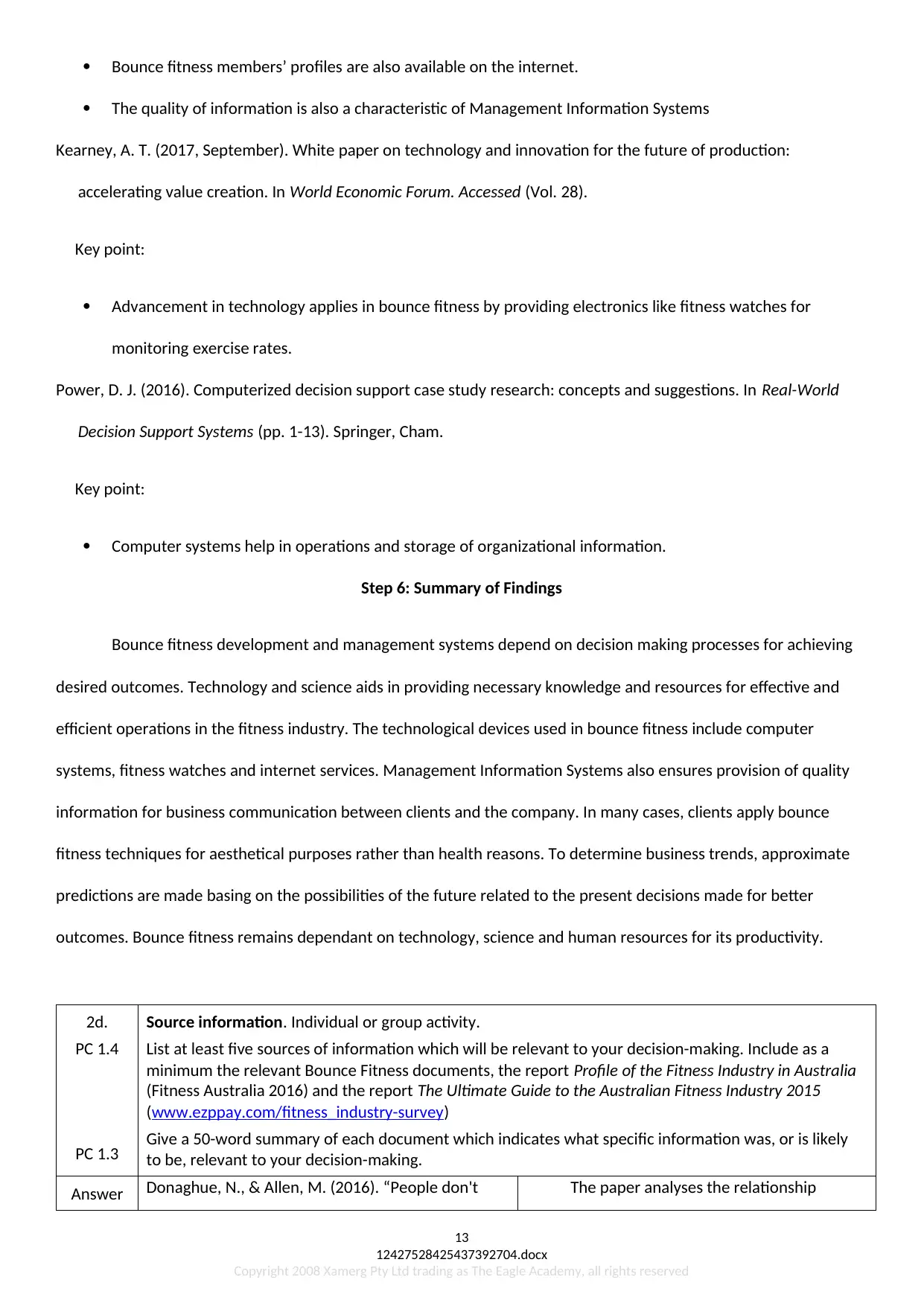
Bounce fitness members’ profiles are also available on the internet.
The quality of information is also a characteristic of Management Information Systems
Kearney, A. T. (2017, September). White paper on technology and innovation for the future of production:
accelerating value creation. In World Economic Forum. Accessed (Vol. 28).
Key point:
Advancement in technology applies in bounce fitness by providing electronics like fitness watches for
monitoring exercise rates.
Power, D. J. (2016). Computerized decision support case study research: concepts and suggestions. In Real-World
Decision Support Systems (pp. 1-13). Springer, Cham.
Key point:
Computer systems help in operations and storage of organizational information.
Step 6: Summary of Findings
Bounce fitness development and management systems depend on decision making processes for achieving
desired outcomes. Technology and science aids in providing necessary knowledge and resources for effective and
efficient operations in the fitness industry. The technological devices used in bounce fitness include computer
systems, fitness watches and internet services. Management Information Systems also ensures provision of quality
information for business communication between clients and the company. In many cases, clients apply bounce
fitness techniques for aesthetical purposes rather than health reasons. To determine business trends, approximate
predictions are made basing on the possibilities of the future related to the present decisions made for better
outcomes. Bounce fitness remains dependant on technology, science and human resources for its productivity.
2d.
PC 1.4
PC 1.3
Source information. Individual or group activity.
List at least five sources of information which will be relevant to your decision-making. Include as a
minimum the relevant Bounce Fitness documents, the report Profile of the Fitness Industry in Australia
(Fitness Australia 2016) and the report The Ultimate Guide to the Australian Fitness Industry 2015
(www.ezppay.com/fitness_industry-survey)
Give a 50-word summary of each document which indicates what specific information was, or is likely
to be, relevant to your decision-making.
Answer Donaghue, N., & Allen, M. (2016). “People don't The paper analyses the relationship
13
12427528425437392704.docx
Copyright 2008 Xamerg Pty Ltd trading as The Eagle Academy, all rights reserved
The quality of information is also a characteristic of Management Information Systems
Kearney, A. T. (2017, September). White paper on technology and innovation for the future of production:
accelerating value creation. In World Economic Forum. Accessed (Vol. 28).
Key point:
Advancement in technology applies in bounce fitness by providing electronics like fitness watches for
monitoring exercise rates.
Power, D. J. (2016). Computerized decision support case study research: concepts and suggestions. In Real-World
Decision Support Systems (pp. 1-13). Springer, Cham.
Key point:
Computer systems help in operations and storage of organizational information.
Step 6: Summary of Findings
Bounce fitness development and management systems depend on decision making processes for achieving
desired outcomes. Technology and science aids in providing necessary knowledge and resources for effective and
efficient operations in the fitness industry. The technological devices used in bounce fitness include computer
systems, fitness watches and internet services. Management Information Systems also ensures provision of quality
information for business communication between clients and the company. In many cases, clients apply bounce
fitness techniques for aesthetical purposes rather than health reasons. To determine business trends, approximate
predictions are made basing on the possibilities of the future related to the present decisions made for better
outcomes. Bounce fitness remains dependant on technology, science and human resources for its productivity.
2d.
PC 1.4
PC 1.3
Source information. Individual or group activity.
List at least five sources of information which will be relevant to your decision-making. Include as a
minimum the relevant Bounce Fitness documents, the report Profile of the Fitness Industry in Australia
(Fitness Australia 2016) and the report The Ultimate Guide to the Australian Fitness Industry 2015
(www.ezppay.com/fitness_industry-survey)
Give a 50-word summary of each document which indicates what specific information was, or is likely
to be, relevant to your decision-making.
Answer Donaghue, N., & Allen, M. (2016). “People don't The paper analyses the relationship
13
12427528425437392704.docx
Copyright 2008 Xamerg Pty Ltd trading as The Eagle Academy, all rights reserved
Paraphrase This Document
Need a fresh take? Get an instant paraphrase of this document with our AI Paraphraser
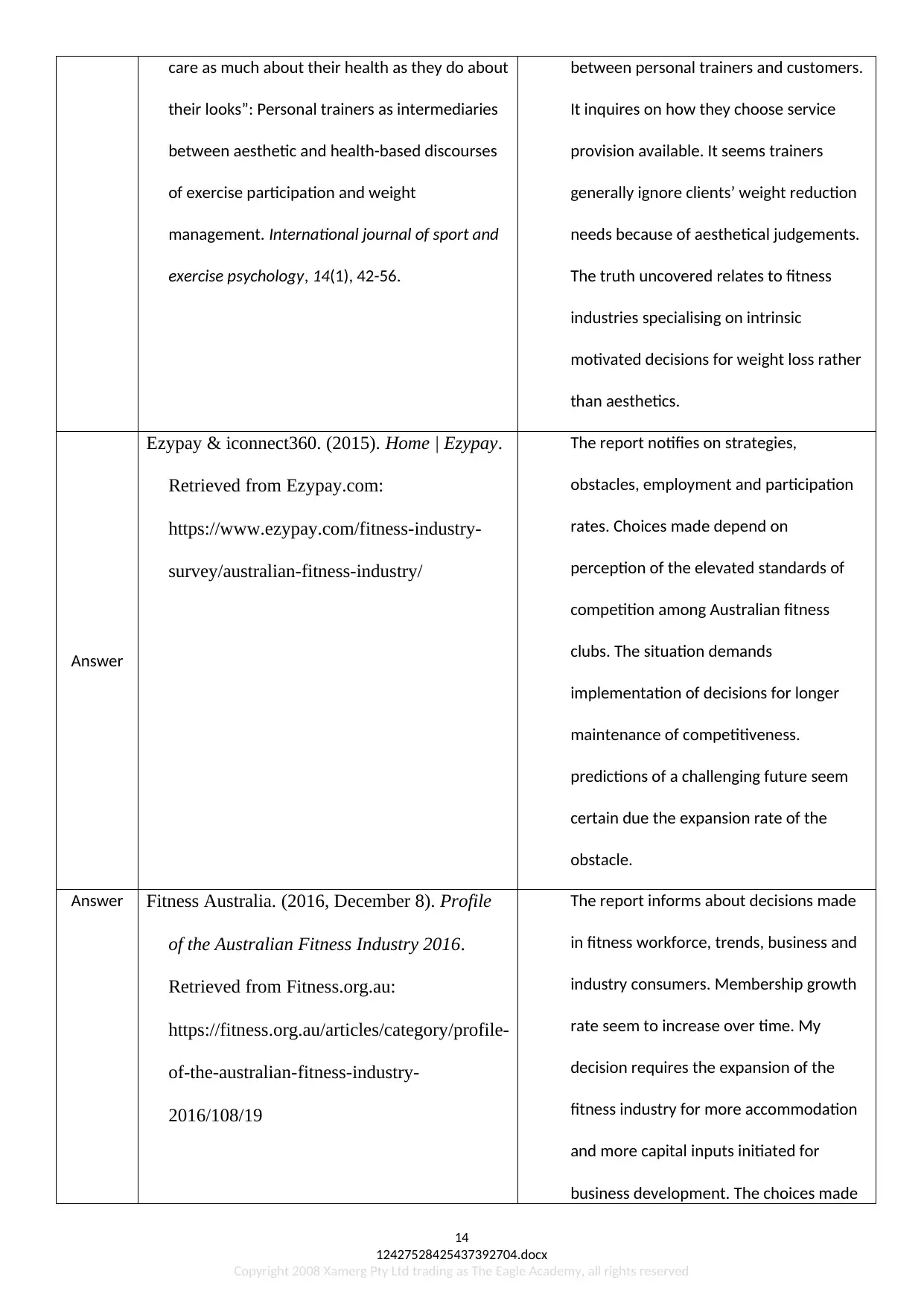
care as much about their health as they do about
their looks”: Personal trainers as intermediaries
between aesthetic and health-based discourses
of exercise participation and weight
management. International journal of sport and
exercise psychology, 14(1), 42-56.
between personal trainers and customers.
It inquires on how they choose service
provision available. It seems trainers
generally ignore clients’ weight reduction
needs because of aesthetical judgements.
The truth uncovered relates to fitness
industries specialising on intrinsic
motivated decisions for weight loss rather
than aesthetics.
Answer
Ezypay & iconnect360. (2015). Home | Ezypay.
Retrieved from Ezypay.com:
https://www.ezypay.com/fitness-industry-
survey/australian-fitness-industry/
The report notifies on strategies,
obstacles, employment and participation
rates. Choices made depend on
perception of the elevated standards of
competition among Australian fitness
clubs. The situation demands
implementation of decisions for longer
maintenance of competitiveness.
predictions of a challenging future seem
certain due the expansion rate of the
obstacle.
Answer Fitness Australia. (2016, December 8). Profile
of the Australian Fitness Industry 2016.
Retrieved from Fitness.org.au:
https://fitness.org.au/articles/category/profile-
of-the-australian-fitness-industry-
2016/108/19
The report informs about decisions made
in fitness workforce, trends, business and
industry consumers. Membership growth
rate seem to increase over time. My
decision requires the expansion of the
fitness industry for more accommodation
and more capital inputs initiated for
business development. The choices made
14
12427528425437392704.docx
Copyright 2008 Xamerg Pty Ltd trading as The Eagle Academy, all rights reserved
their looks”: Personal trainers as intermediaries
between aesthetic and health-based discourses
of exercise participation and weight
management. International journal of sport and
exercise psychology, 14(1), 42-56.
between personal trainers and customers.
It inquires on how they choose service
provision available. It seems trainers
generally ignore clients’ weight reduction
needs because of aesthetical judgements.
The truth uncovered relates to fitness
industries specialising on intrinsic
motivated decisions for weight loss rather
than aesthetics.
Answer
Ezypay & iconnect360. (2015). Home | Ezypay.
Retrieved from Ezypay.com:
https://www.ezypay.com/fitness-industry-
survey/australian-fitness-industry/
The report notifies on strategies,
obstacles, employment and participation
rates. Choices made depend on
perception of the elevated standards of
competition among Australian fitness
clubs. The situation demands
implementation of decisions for longer
maintenance of competitiveness.
predictions of a challenging future seem
certain due the expansion rate of the
obstacle.
Answer Fitness Australia. (2016, December 8). Profile
of the Australian Fitness Industry 2016.
Retrieved from Fitness.org.au:
https://fitness.org.au/articles/category/profile-
of-the-australian-fitness-industry-
2016/108/19
The report informs about decisions made
in fitness workforce, trends, business and
industry consumers. Membership growth
rate seem to increase over time. My
decision requires the expansion of the
fitness industry for more accommodation
and more capital inputs initiated for
business development. The choices made
14
12427528425437392704.docx
Copyright 2008 Xamerg Pty Ltd trading as The Eagle Academy, all rights reserved

affects the industry’s production rate.
Answer
Jansen, R. J., Curşeu, P. L., Vermeulen, P. A., Geurts,
J. L., & Gibcus, P. (2013). Information processing
and strategic decision-making in small and
medium-sized enterprises: The role of human
and social capital in attaining decision
effectiveness. International small business
journal, 31(2), 192-216.
The decision-making literature focuses on
consequences of personal choices,
interpretations and cordial links. They determine
the effectiveness and impacts of decisions in the
samples of various small-scale businesses.
Findings indicate that capital determines
consequences of business actions through
assessments. However, the processes appear
less relevant to medium-scale and large-scale
industries.
Answer
Power, D. J., Sharda, R., & Burstein, F.
(2015). Decision support systems. John Wiley &
Sons, Ltd.
The authors define Decision Support
Systems (DSS) as a type of computer
information organization. They are
antiques designed for certain purpose.
Their classes include systems directed by
data, communications, document, model
and knowledge. Whinston and Holsapple
categorization involved orientation of DSS
in text, database, rule, solver, spreadsheet
and compound forms.
2e.
PC 1.5
Test information. Individual or group activity.
In relation to the research information gathered, define the difference between reliability and
validity of information.
How did you determine that each of the sources used is likely to be deemed a reliable and valid
source of information?
Answer Reliability of information involves comparing knowledge sources for consistency while validity of
information focuses more on the strength of the result from hypothetical view.
Answer . I used the test and retest technique by reading all their content to determine their relationship. I
checked their internal consistency by formulating various types of questions and searching for
answers from different sources and they all contained parallel expertise (Rosemann & vom Brocke,
2015). I measured validity of each of the sources by checking the connection between their
conclusion and details on the topic (Raciti, Ward & Dagger, 2013). All the sources seem right hence
15
12427528425437392704.docx
Copyright 2008 Xamerg Pty Ltd trading as The Eagle Academy, all rights reserved
Answer
Jansen, R. J., Curşeu, P. L., Vermeulen, P. A., Geurts,
J. L., & Gibcus, P. (2013). Information processing
and strategic decision-making in small and
medium-sized enterprises: The role of human
and social capital in attaining decision
effectiveness. International small business
journal, 31(2), 192-216.
The decision-making literature focuses on
consequences of personal choices,
interpretations and cordial links. They determine
the effectiveness and impacts of decisions in the
samples of various small-scale businesses.
Findings indicate that capital determines
consequences of business actions through
assessments. However, the processes appear
less relevant to medium-scale and large-scale
industries.
Answer
Power, D. J., Sharda, R., & Burstein, F.
(2015). Decision support systems. John Wiley &
Sons, Ltd.
The authors define Decision Support
Systems (DSS) as a type of computer
information organization. They are
antiques designed for certain purpose.
Their classes include systems directed by
data, communications, document, model
and knowledge. Whinston and Holsapple
categorization involved orientation of DSS
in text, database, rule, solver, spreadsheet
and compound forms.
2e.
PC 1.5
Test information. Individual or group activity.
In relation to the research information gathered, define the difference between reliability and
validity of information.
How did you determine that each of the sources used is likely to be deemed a reliable and valid
source of information?
Answer Reliability of information involves comparing knowledge sources for consistency while validity of
information focuses more on the strength of the result from hypothetical view.
Answer . I used the test and retest technique by reading all their content to determine their relationship. I
checked their internal consistency by formulating various types of questions and searching for
answers from different sources and they all contained parallel expertise (Rosemann & vom Brocke,
2015). I measured validity of each of the sources by checking the connection between their
conclusion and details on the topic (Raciti, Ward & Dagger, 2013). All the sources seem right hence
15
12427528425437392704.docx
Copyright 2008 Xamerg Pty Ltd trading as The Eagle Academy, all rights reserved
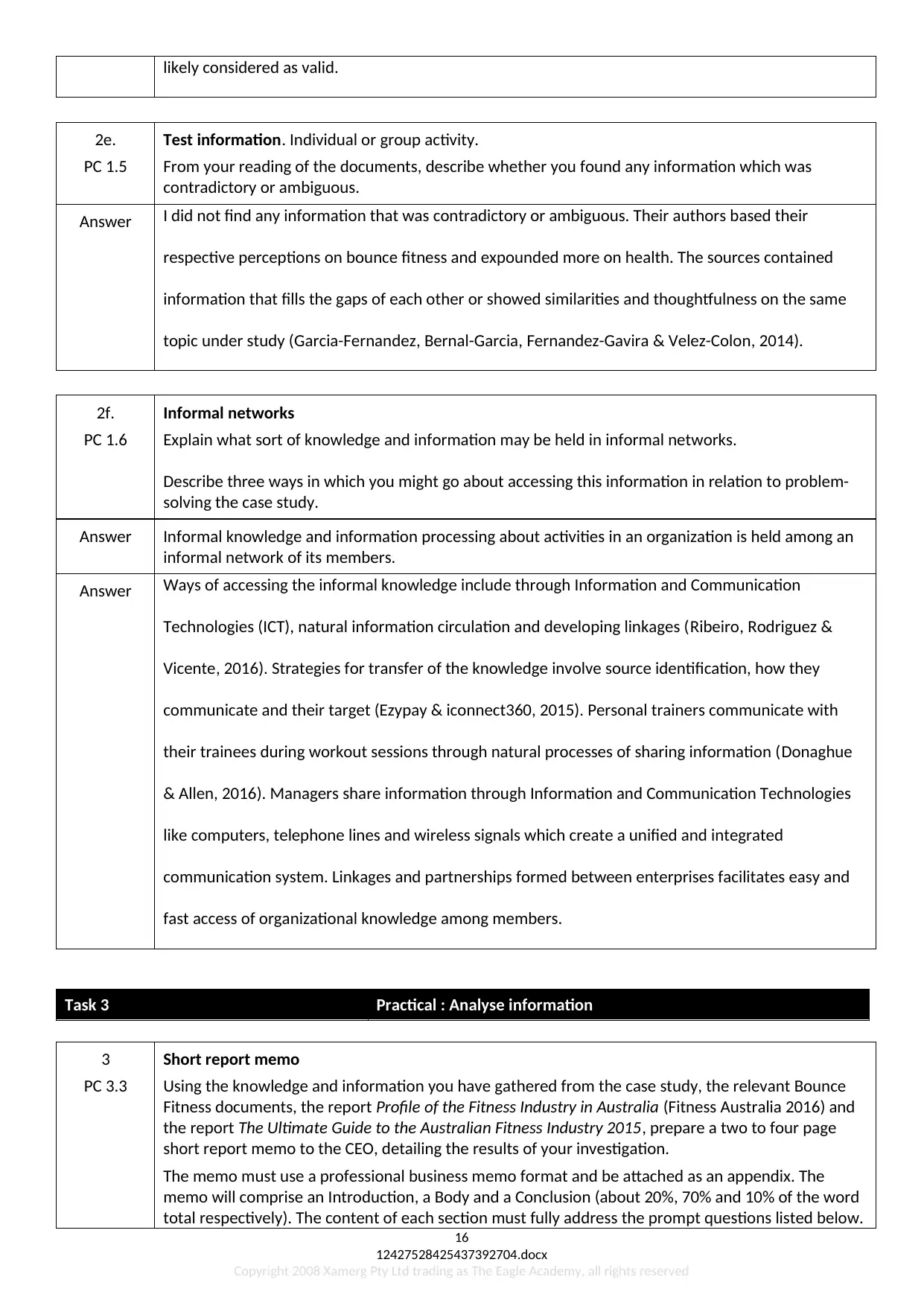
likely considered as valid.
2e.
PC 1.5
Test information. Individual or group activity.
From your reading of the documents, describe whether you found any information which was
contradictory or ambiguous.
Answer I did not find any information that was contradictory or ambiguous. Their authors based their
respective perceptions on bounce fitness and expounded more on health. The sources contained
information that fills the gaps of each other or showed similarities and thoughtfulness on the same
topic under study (Garcia-Fernandez, Bernal-Garcia, Fernandez-Gavira & Velez-Colon, 2014).
2f.
PC 1.6
Informal networks
Explain what sort of knowledge and information may be held in informal networks.
Describe three ways in which you might go about accessing this information in relation to problem-
solving the case study.
Answer Informal knowledge and information processing about activities in an organization is held among an
informal network of its members.
Answer Ways of accessing the informal knowledge include through Information and Communication
Technologies (ICT), natural information circulation and developing linkages (Ribeiro, Rodriguez &
Vicente, 2016). Strategies for transfer of the knowledge involve source identification, how they
communicate and their target (Ezypay & iconnect360, 2015). Personal trainers communicate with
their trainees during workout sessions through natural processes of sharing information (Donaghue
& Allen, 2016). Managers share information through Information and Communication Technologies
like computers, telephone lines and wireless signals which create a unified and integrated
communication system. Linkages and partnerships formed between enterprises facilitates easy and
fast access of organizational knowledge among members.
Task 3 Practical : Analyse information
3
PC 3.3
Short report memo
Using the knowledge and information you have gathered from the case study, the relevant Bounce
Fitness documents, the report Profile of the Fitness Industry in Australia (Fitness Australia 2016) and
the report The Ultimate Guide to the Australian Fitness Industry 2015, prepare a two to four page
short report memo to the CEO, detailing the results of your investigation.
The memo must use a professional business memo format and be attached as an appendix. The
memo will comprise an Introduction, a Body and a Conclusion (about 20%, 70% and 10% of the word
total respectively). The content of each section must fully address the prompt questions listed below.
16
12427528425437392704.docx
Copyright 2008 Xamerg Pty Ltd trading as The Eagle Academy, all rights reserved
2e.
PC 1.5
Test information. Individual or group activity.
From your reading of the documents, describe whether you found any information which was
contradictory or ambiguous.
Answer I did not find any information that was contradictory or ambiguous. Their authors based their
respective perceptions on bounce fitness and expounded more on health. The sources contained
information that fills the gaps of each other or showed similarities and thoughtfulness on the same
topic under study (Garcia-Fernandez, Bernal-Garcia, Fernandez-Gavira & Velez-Colon, 2014).
2f.
PC 1.6
Informal networks
Explain what sort of knowledge and information may be held in informal networks.
Describe three ways in which you might go about accessing this information in relation to problem-
solving the case study.
Answer Informal knowledge and information processing about activities in an organization is held among an
informal network of its members.
Answer Ways of accessing the informal knowledge include through Information and Communication
Technologies (ICT), natural information circulation and developing linkages (Ribeiro, Rodriguez &
Vicente, 2016). Strategies for transfer of the knowledge involve source identification, how they
communicate and their target (Ezypay & iconnect360, 2015). Personal trainers communicate with
their trainees during workout sessions through natural processes of sharing information (Donaghue
& Allen, 2016). Managers share information through Information and Communication Technologies
like computers, telephone lines and wireless signals which create a unified and integrated
communication system. Linkages and partnerships formed between enterprises facilitates easy and
fast access of organizational knowledge among members.
Task 3 Practical : Analyse information
3
PC 3.3
Short report memo
Using the knowledge and information you have gathered from the case study, the relevant Bounce
Fitness documents, the report Profile of the Fitness Industry in Australia (Fitness Australia 2016) and
the report The Ultimate Guide to the Australian Fitness Industry 2015, prepare a two to four page
short report memo to the CEO, detailing the results of your investigation.
The memo must use a professional business memo format and be attached as an appendix. The
memo will comprise an Introduction, a Body and a Conclusion (about 20%, 70% and 10% of the word
total respectively). The content of each section must fully address the prompt questions listed below.
16
12427528425437392704.docx
Copyright 2008 Xamerg Pty Ltd trading as The Eagle Academy, all rights reserved
Secure Best Marks with AI Grader
Need help grading? Try our AI Grader for instant feedback on your assignments.
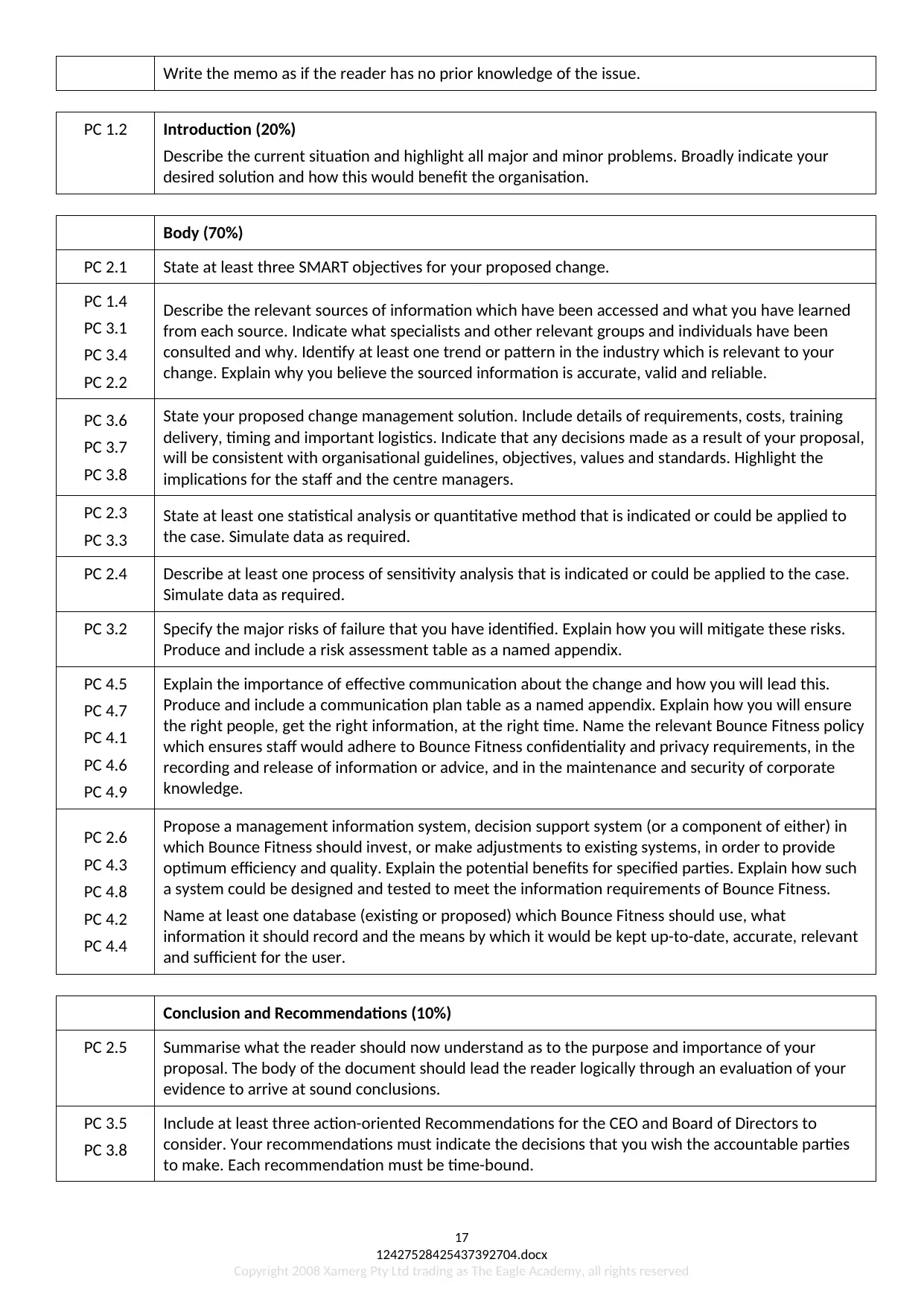
Write the memo as if the reader has no prior knowledge of the issue.
PC 1.2 Introduction (20%)
Describe the current situation and highlight all major and minor problems. Broadly indicate your
desired solution and how this would benefit the organisation.
Body (70%)
PC 2.1 State at least three SMART objectives for your proposed change.
PC 1.4
PC 3.1
PC 3.4
PC 2.2
Describe the relevant sources of information which have been accessed and what you have learned
from each source. Indicate what specialists and other relevant groups and individuals have been
consulted and why. Identify at least one trend or pattern in the industry which is relevant to your
change. Explain why you believe the sourced information is accurate, valid and reliable.
PC 3.6
PC 3.7
PC 3.8
State your proposed change management solution. Include details of requirements, costs, training
delivery, timing and important logistics. Indicate that any decisions made as a result of your proposal,
will be consistent with organisational guidelines, objectives, values and standards. Highlight the
implications for the staff and the centre managers.
PC 2.3
PC 3.3
State at least one statistical analysis or quantitative method that is indicated or could be applied to
the case. Simulate data as required.
PC 2.4 Describe at least one process of sensitivity analysis that is indicated or could be applied to the case.
Simulate data as required.
PC 3.2 Specify the major risks of failure that you have identified. Explain how you will mitigate these risks.
Produce and include a risk assessment table as a named appendix.
PC 4.5
PC 4.7
PC 4.1
PC 4.6
PC 4.9
Explain the importance of effective communication about the change and how you will lead this.
Produce and include a communication plan table as a named appendix. Explain how you will ensure
the right people, get the right information, at the right time. Name the relevant Bounce Fitness policy
which ensures staff would adhere to Bounce Fitness confidentiality and privacy requirements, in the
recording and release of information or advice, and in the maintenance and security of corporate
knowledge.
PC 2.6
PC 4.3
PC 4.8
PC 4.2
PC 4.4
Propose a management information system, decision support system (or a component of either) in
which Bounce Fitness should invest, or make adjustments to existing systems, in order to provide
optimum efficiency and quality. Explain the potential benefits for specified parties. Explain how such
a system could be designed and tested to meet the information requirements of Bounce Fitness.
Name at least one database (existing or proposed) which Bounce Fitness should use, what
information it should record and the means by which it would be kept up-to-date, accurate, relevant
and sufficient for the user.
Conclusion and Recommendations (10%)
PC 2.5 Summarise what the reader should now understand as to the purpose and importance of your
proposal. The body of the document should lead the reader logically through an evaluation of your
evidence to arrive at sound conclusions.
PC 3.5
PC 3.8
Include at least three action-oriented Recommendations for the CEO and Board of Directors to
consider. Your recommendations must indicate the decisions that you wish the accountable parties
to make. Each recommendation must be time-bound.
17
12427528425437392704.docx
Copyright 2008 Xamerg Pty Ltd trading as The Eagle Academy, all rights reserved
PC 1.2 Introduction (20%)
Describe the current situation and highlight all major and minor problems. Broadly indicate your
desired solution and how this would benefit the organisation.
Body (70%)
PC 2.1 State at least three SMART objectives for your proposed change.
PC 1.4
PC 3.1
PC 3.4
PC 2.2
Describe the relevant sources of information which have been accessed and what you have learned
from each source. Indicate what specialists and other relevant groups and individuals have been
consulted and why. Identify at least one trend or pattern in the industry which is relevant to your
change. Explain why you believe the sourced information is accurate, valid and reliable.
PC 3.6
PC 3.7
PC 3.8
State your proposed change management solution. Include details of requirements, costs, training
delivery, timing and important logistics. Indicate that any decisions made as a result of your proposal,
will be consistent with organisational guidelines, objectives, values and standards. Highlight the
implications for the staff and the centre managers.
PC 2.3
PC 3.3
State at least one statistical analysis or quantitative method that is indicated or could be applied to
the case. Simulate data as required.
PC 2.4 Describe at least one process of sensitivity analysis that is indicated or could be applied to the case.
Simulate data as required.
PC 3.2 Specify the major risks of failure that you have identified. Explain how you will mitigate these risks.
Produce and include a risk assessment table as a named appendix.
PC 4.5
PC 4.7
PC 4.1
PC 4.6
PC 4.9
Explain the importance of effective communication about the change and how you will lead this.
Produce and include a communication plan table as a named appendix. Explain how you will ensure
the right people, get the right information, at the right time. Name the relevant Bounce Fitness policy
which ensures staff would adhere to Bounce Fitness confidentiality and privacy requirements, in the
recording and release of information or advice, and in the maintenance and security of corporate
knowledge.
PC 2.6
PC 4.3
PC 4.8
PC 4.2
PC 4.4
Propose a management information system, decision support system (or a component of either) in
which Bounce Fitness should invest, or make adjustments to existing systems, in order to provide
optimum efficiency and quality. Explain the potential benefits for specified parties. Explain how such
a system could be designed and tested to meet the information requirements of Bounce Fitness.
Name at least one database (existing or proposed) which Bounce Fitness should use, what
information it should record and the means by which it would be kept up-to-date, accurate, relevant
and sufficient for the user.
Conclusion and Recommendations (10%)
PC 2.5 Summarise what the reader should now understand as to the purpose and importance of your
proposal. The body of the document should lead the reader logically through an evaluation of your
evidence to arrive at sound conclusions.
PC 3.5
PC 3.8
Include at least three action-oriented Recommendations for the CEO and Board of Directors to
consider. Your recommendations must indicate the decisions that you wish the accountable parties
to make. Each recommendation must be time-bound.
17
12427528425437392704.docx
Copyright 2008 Xamerg Pty Ltd trading as The Eagle Academy, all rights reserved
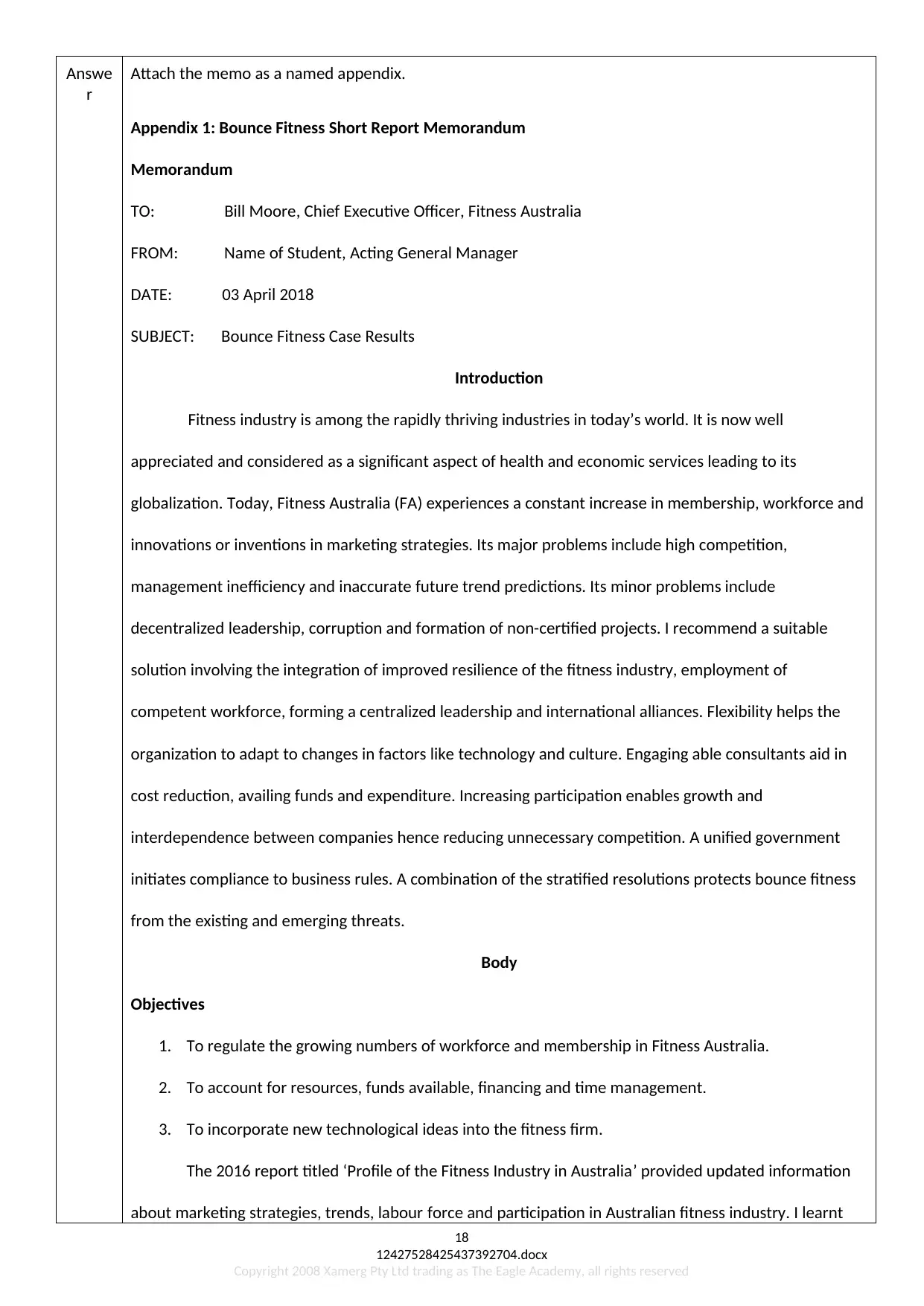
Answe
r
Attach the memo as a named appendix.
Appendix 1: Bounce Fitness Short Report Memorandum
Memorandum
TO: Bill Moore, Chief Executive Officer, Fitness Australia
FROM: Name of Student, Acting General Manager
DATE: 03 April 2018
SUBJECT: Bounce Fitness Case Results
Introduction
Fitness industry is among the rapidly thriving industries in today’s world. It is now well
appreciated and considered as a significant aspect of health and economic services leading to its
globalization. Today, Fitness Australia (FA) experiences a constant increase in membership, workforce and
innovations or inventions in marketing strategies. Its major problems include high competition,
management inefficiency and inaccurate future trend predictions. Its minor problems include
decentralized leadership, corruption and formation of non-certified projects. I recommend a suitable
solution involving the integration of improved resilience of the fitness industry, employment of
competent workforce, forming a centralized leadership and international alliances. Flexibility helps the
organization to adapt to changes in factors like technology and culture. Engaging able consultants aid in
cost reduction, availing funds and expenditure. Increasing participation enables growth and
interdependence between companies hence reducing unnecessary competition. A unified government
initiates compliance to business rules. A combination of the stratified resolutions protects bounce fitness
from the existing and emerging threats.
Body
Objectives
1. To regulate the growing numbers of workforce and membership in Fitness Australia.
2. To account for resources, funds available, financing and time management.
3. To incorporate new technological ideas into the fitness firm.
The 2016 report titled ‘Profile of the Fitness Industry in Australia’ provided updated information
about marketing strategies, trends, labour force and participation in Australian fitness industry. I learnt
18
12427528425437392704.docx
Copyright 2008 Xamerg Pty Ltd trading as The Eagle Academy, all rights reserved
r
Attach the memo as a named appendix.
Appendix 1: Bounce Fitness Short Report Memorandum
Memorandum
TO: Bill Moore, Chief Executive Officer, Fitness Australia
FROM: Name of Student, Acting General Manager
DATE: 03 April 2018
SUBJECT: Bounce Fitness Case Results
Introduction
Fitness industry is among the rapidly thriving industries in today’s world. It is now well
appreciated and considered as a significant aspect of health and economic services leading to its
globalization. Today, Fitness Australia (FA) experiences a constant increase in membership, workforce and
innovations or inventions in marketing strategies. Its major problems include high competition,
management inefficiency and inaccurate future trend predictions. Its minor problems include
decentralized leadership, corruption and formation of non-certified projects. I recommend a suitable
solution involving the integration of improved resilience of the fitness industry, employment of
competent workforce, forming a centralized leadership and international alliances. Flexibility helps the
organization to adapt to changes in factors like technology and culture. Engaging able consultants aid in
cost reduction, availing funds and expenditure. Increasing participation enables growth and
interdependence between companies hence reducing unnecessary competition. A unified government
initiates compliance to business rules. A combination of the stratified resolutions protects bounce fitness
from the existing and emerging threats.
Body
Objectives
1. To regulate the growing numbers of workforce and membership in Fitness Australia.
2. To account for resources, funds available, financing and time management.
3. To incorporate new technological ideas into the fitness firm.
The 2016 report titled ‘Profile of the Fitness Industry in Australia’ provided updated information
about marketing strategies, trends, labour force and participation in Australian fitness industry. I learnt
18
12427528425437392704.docx
Copyright 2008 Xamerg Pty Ltd trading as The Eagle Academy, all rights reserved
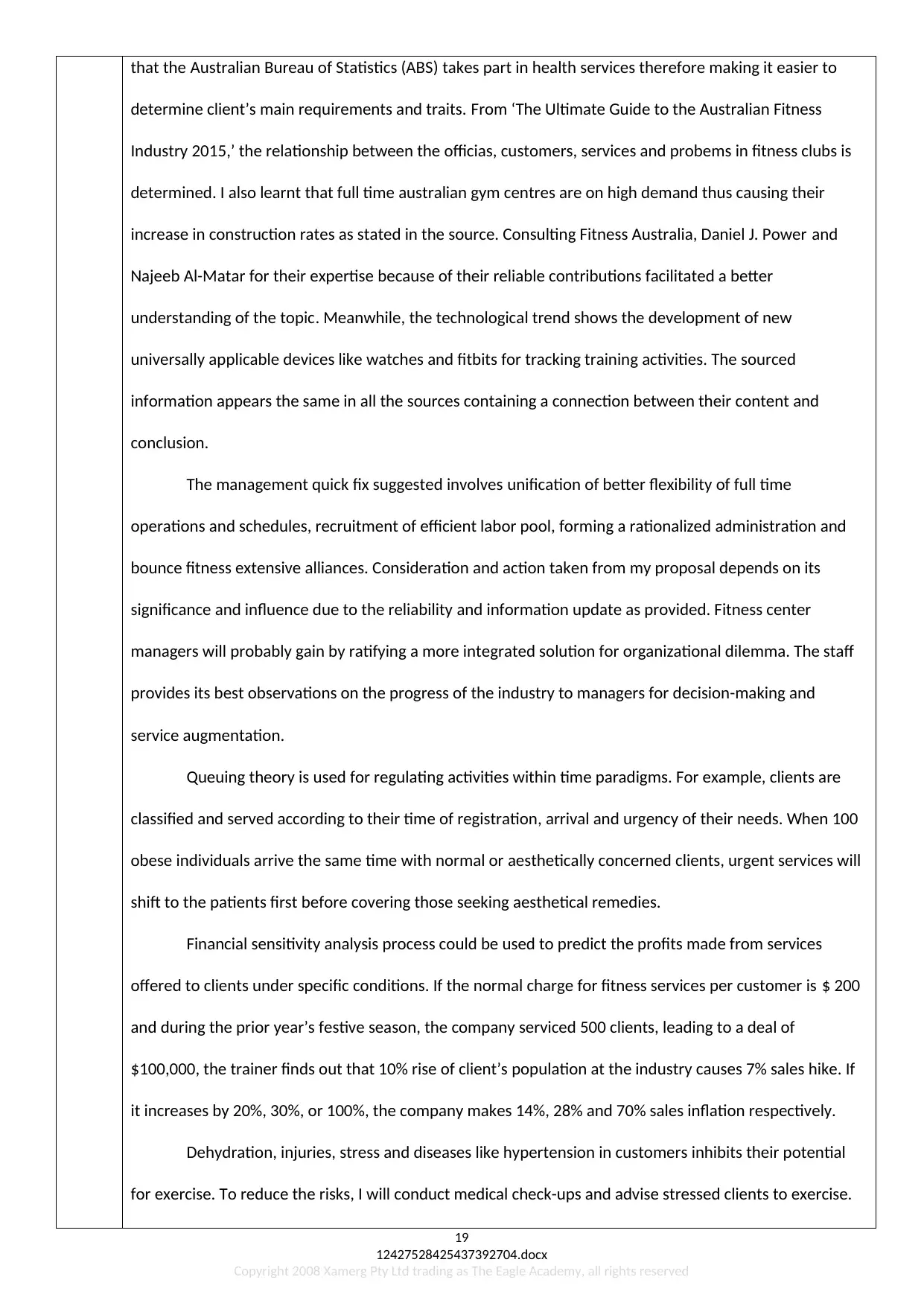
that the Australian Bureau of Statistics (ABS) takes part in health services therefore making it easier to
determine client’s main requirements and traits. From ‘The Ultimate Guide to the Australian Fitness
Industry 2015,’ the relationship between the officias, customers, services and probems in fitness clubs is
determined. I also learnt that full time australian gym centres are on high demand thus causing their
increase in construction rates as stated in the source. Consulting Fitness Australia, Daniel J. Power and
Najeeb Al-Matar for their expertise because of their reliable contributions facilitated a better
understanding of the topic. Meanwhile, the technological trend shows the development of new
universally applicable devices like watches and fitbits for tracking training activities. The sourced
information appears the same in all the sources containing a connection between their content and
conclusion.
The management quick fix suggested involves unification of better flexibility of full time
operations and schedules, recruitment of efficient labor pool, forming a rationalized administration and
bounce fitness extensive alliances. Consideration and action taken from my proposal depends on its
significance and influence due to the reliability and information update as provided. Fitness center
managers will probably gain by ratifying a more integrated solution for organizational dilemma. The staff
provides its best observations on the progress of the industry to managers for decision-making and
service augmentation.
Queuing theory is used for regulating activities within time paradigms. For example, clients are
classified and served according to their time of registration, arrival and urgency of their needs. When 100
obese individuals arrive the same time with normal or aesthetically concerned clients, urgent services will
shift to the patients first before covering those seeking aesthetical remedies.
Financial sensitivity analysis process could be used to predict the profits made from services
offered to clients under specific conditions. If the normal charge for fitness services per customer is $ 200
and during the prior year’s festive season, the company serviced 500 clients, leading to a deal of
$100,000, the trainer finds out that 10% rise of client’s population at the industry causes 7% sales hike. If
it increases by 20%, 30%, or 100%, the company makes 14%, 28% and 70% sales inflation respectively.
Dehydration, injuries, stress and diseases like hypertension in customers inhibits their potential
for exercise. To reduce the risks, I will conduct medical check-ups and advise stressed clients to exercise.
19
12427528425437392704.docx
Copyright 2008 Xamerg Pty Ltd trading as The Eagle Academy, all rights reserved
determine client’s main requirements and traits. From ‘The Ultimate Guide to the Australian Fitness
Industry 2015,’ the relationship between the officias, customers, services and probems in fitness clubs is
determined. I also learnt that full time australian gym centres are on high demand thus causing their
increase in construction rates as stated in the source. Consulting Fitness Australia, Daniel J. Power and
Najeeb Al-Matar for their expertise because of their reliable contributions facilitated a better
understanding of the topic. Meanwhile, the technological trend shows the development of new
universally applicable devices like watches and fitbits for tracking training activities. The sourced
information appears the same in all the sources containing a connection between their content and
conclusion.
The management quick fix suggested involves unification of better flexibility of full time
operations and schedules, recruitment of efficient labor pool, forming a rationalized administration and
bounce fitness extensive alliances. Consideration and action taken from my proposal depends on its
significance and influence due to the reliability and information update as provided. Fitness center
managers will probably gain by ratifying a more integrated solution for organizational dilemma. The staff
provides its best observations on the progress of the industry to managers for decision-making and
service augmentation.
Queuing theory is used for regulating activities within time paradigms. For example, clients are
classified and served according to their time of registration, arrival and urgency of their needs. When 100
obese individuals arrive the same time with normal or aesthetically concerned clients, urgent services will
shift to the patients first before covering those seeking aesthetical remedies.
Financial sensitivity analysis process could be used to predict the profits made from services
offered to clients under specific conditions. If the normal charge for fitness services per customer is $ 200
and during the prior year’s festive season, the company serviced 500 clients, leading to a deal of
$100,000, the trainer finds out that 10% rise of client’s population at the industry causes 7% sales hike. If
it increases by 20%, 30%, or 100%, the company makes 14%, 28% and 70% sales inflation respectively.
Dehydration, injuries, stress and diseases like hypertension in customers inhibits their potential
for exercise. To reduce the risks, I will conduct medical check-ups and advise stressed clients to exercise.
19
12427528425437392704.docx
Copyright 2008 Xamerg Pty Ltd trading as The Eagle Academy, all rights reserved
Paraphrase This Document
Need a fresh take? Get an instant paraphrase of this document with our AI Paraphraser
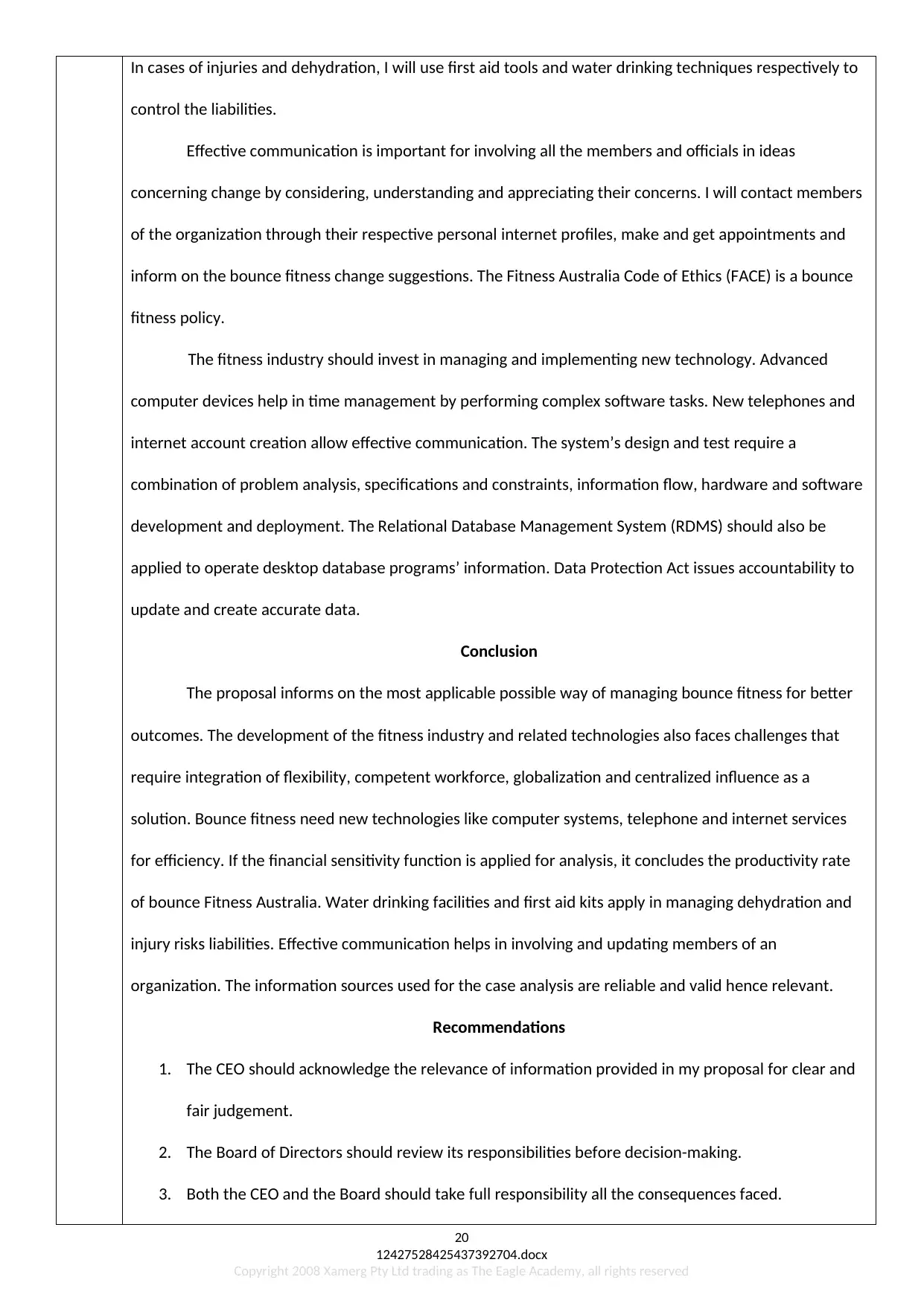
In cases of injuries and dehydration, I will use first aid tools and water drinking techniques respectively to
control the liabilities.
Effective communication is important for involving all the members and officials in ideas
concerning change by considering, understanding and appreciating their concerns. I will contact members
of the organization through their respective personal internet profiles, make and get appointments and
inform on the bounce fitness change suggestions. The Fitness Australia Code of Ethics (FACE) is a bounce
fitness policy.
The fitness industry should invest in managing and implementing new technology. Advanced
computer devices help in time management by performing complex software tasks. New telephones and
internet account creation allow effective communication. The system’s design and test require a
combination of problem analysis, specifications and constraints, information flow, hardware and software
development and deployment. The Relational Database Management System (RDMS) should also be
applied to operate desktop database programs’ information. Data Protection Act issues accountability to
update and create accurate data.
Conclusion
The proposal informs on the most applicable possible way of managing bounce fitness for better
outcomes. The development of the fitness industry and related technologies also faces challenges that
require integration of flexibility, competent workforce, globalization and centralized influence as a
solution. Bounce fitness need new technologies like computer systems, telephone and internet services
for efficiency. If the financial sensitivity function is applied for analysis, it concludes the productivity rate
of bounce Fitness Australia. Water drinking facilities and first aid kits apply in managing dehydration and
injury risks liabilities. Effective communication helps in involving and updating members of an
organization. The information sources used for the case analysis are reliable and valid hence relevant.
Recommendations
1. The CEO should acknowledge the relevance of information provided in my proposal for clear and
fair judgement.
2. The Board of Directors should review its responsibilities before decision-making.
3. Both the CEO and the Board should take full responsibility all the consequences faced.
20
12427528425437392704.docx
Copyright 2008 Xamerg Pty Ltd trading as The Eagle Academy, all rights reserved
control the liabilities.
Effective communication is important for involving all the members and officials in ideas
concerning change by considering, understanding and appreciating their concerns. I will contact members
of the organization through their respective personal internet profiles, make and get appointments and
inform on the bounce fitness change suggestions. The Fitness Australia Code of Ethics (FACE) is a bounce
fitness policy.
The fitness industry should invest in managing and implementing new technology. Advanced
computer devices help in time management by performing complex software tasks. New telephones and
internet account creation allow effective communication. The system’s design and test require a
combination of problem analysis, specifications and constraints, information flow, hardware and software
development and deployment. The Relational Database Management System (RDMS) should also be
applied to operate desktop database programs’ information. Data Protection Act issues accountability to
update and create accurate data.
Conclusion
The proposal informs on the most applicable possible way of managing bounce fitness for better
outcomes. The development of the fitness industry and related technologies also faces challenges that
require integration of flexibility, competent workforce, globalization and centralized influence as a
solution. Bounce fitness need new technologies like computer systems, telephone and internet services
for efficiency. If the financial sensitivity function is applied for analysis, it concludes the productivity rate
of bounce Fitness Australia. Water drinking facilities and first aid kits apply in managing dehydration and
injury risks liabilities. Effective communication helps in involving and updating members of an
organization. The information sources used for the case analysis are reliable and valid hence relevant.
Recommendations
1. The CEO should acknowledge the relevance of information provided in my proposal for clear and
fair judgement.
2. The Board of Directors should review its responsibilities before decision-making.
3. Both the CEO and the Board should take full responsibility all the consequences faced.
20
12427528425437392704.docx
Copyright 2008 Xamerg Pty Ltd trading as The Eagle Academy, all rights reserved
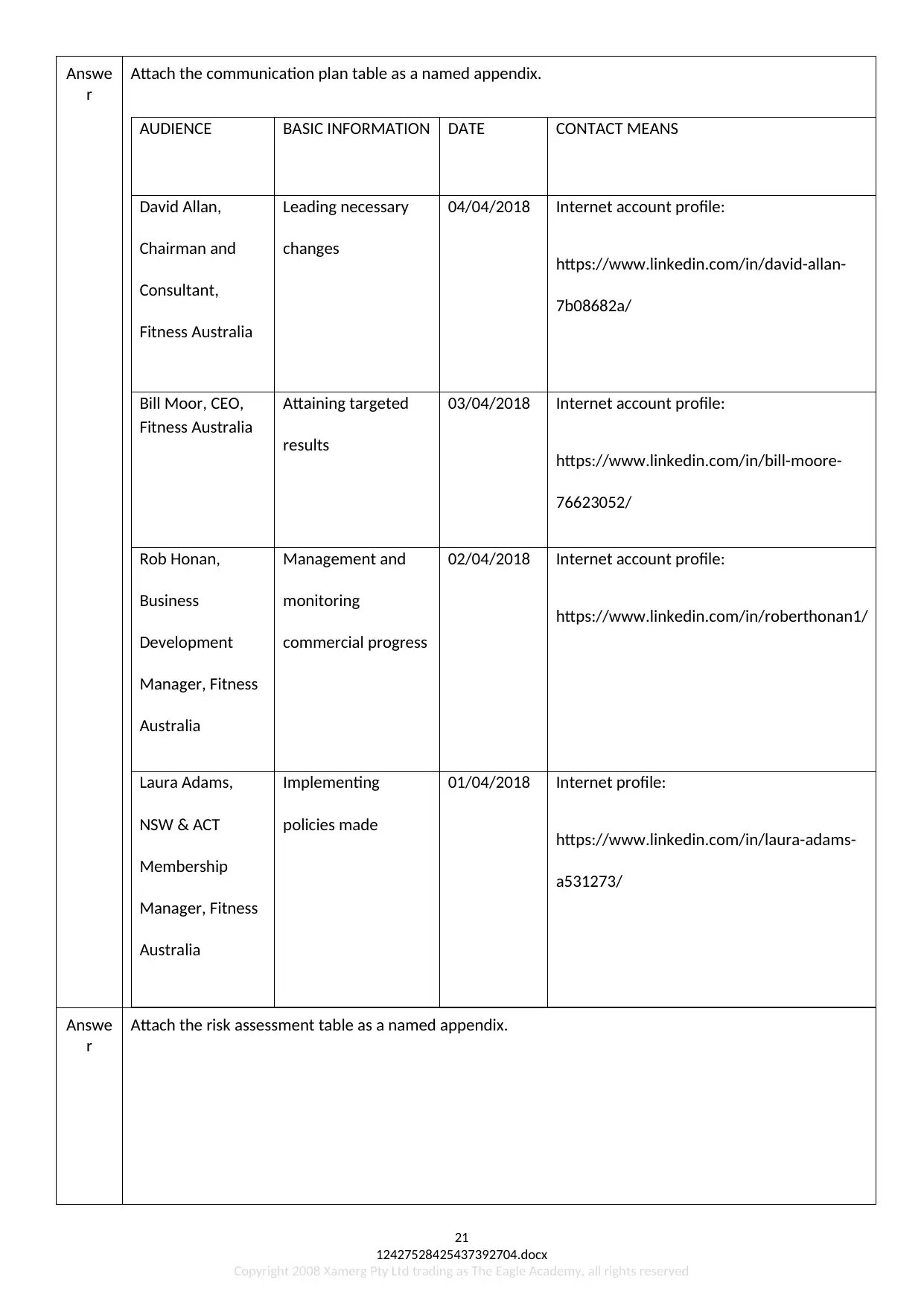
Answe
r
Attach the communication plan table as a named appendix.
AUDIENCE BASIC INFORMATION DATE CONTACT MEANS
David Allan,
Chairman and
Consultant,
Fitness Australia
Leading necessary
changes
04/04/2018 Internet account profile:
https://www.linkedin.com/in/david-allan-
7b08682a/
Bill Moor, CEO,
Fitness Australia
Attaining targeted
results
03/04/2018 Internet account profile:
https://www.linkedin.com/in/bill-moore-
76623052/
Rob Honan,
Business
Development
Manager, Fitness
Australia
Management and
monitoring
commercial progress
02/04/2018 Internet account profile:
https://www.linkedin.com/in/roberthonan1/
Laura Adams,
NSW & ACT
Membership
Manager, Fitness
Australia
Implementing
policies made
01/04/2018 Internet profile:
https://www.linkedin.com/in/laura-adams-
a531273/
Answe
r
Attach the risk assessment table as a named appendix.
21
12427528425437392704.docx
Copyright 2008 Xamerg Pty Ltd trading as The Eagle Academy, all rights reserved
r
Attach the communication plan table as a named appendix.
AUDIENCE BASIC INFORMATION DATE CONTACT MEANS
David Allan,
Chairman and
Consultant,
Fitness Australia
Leading necessary
changes
04/04/2018 Internet account profile:
https://www.linkedin.com/in/david-allan-
7b08682a/
Bill Moor, CEO,
Fitness Australia
Attaining targeted
results
03/04/2018 Internet account profile:
https://www.linkedin.com/in/bill-moore-
76623052/
Rob Honan,
Business
Development
Manager, Fitness
Australia
Management and
monitoring
commercial progress
02/04/2018 Internet account profile:
https://www.linkedin.com/in/roberthonan1/
Laura Adams,
NSW & ACT
Membership
Manager, Fitness
Australia
Implementing
policies made
01/04/2018 Internet profile:
https://www.linkedin.com/in/laura-adams-
a531273/
Answe
r
Attach the risk assessment table as a named appendix.
21
12427528425437392704.docx
Copyright 2008 Xamerg Pty Ltd trading as The Eagle Academy, all rights reserved
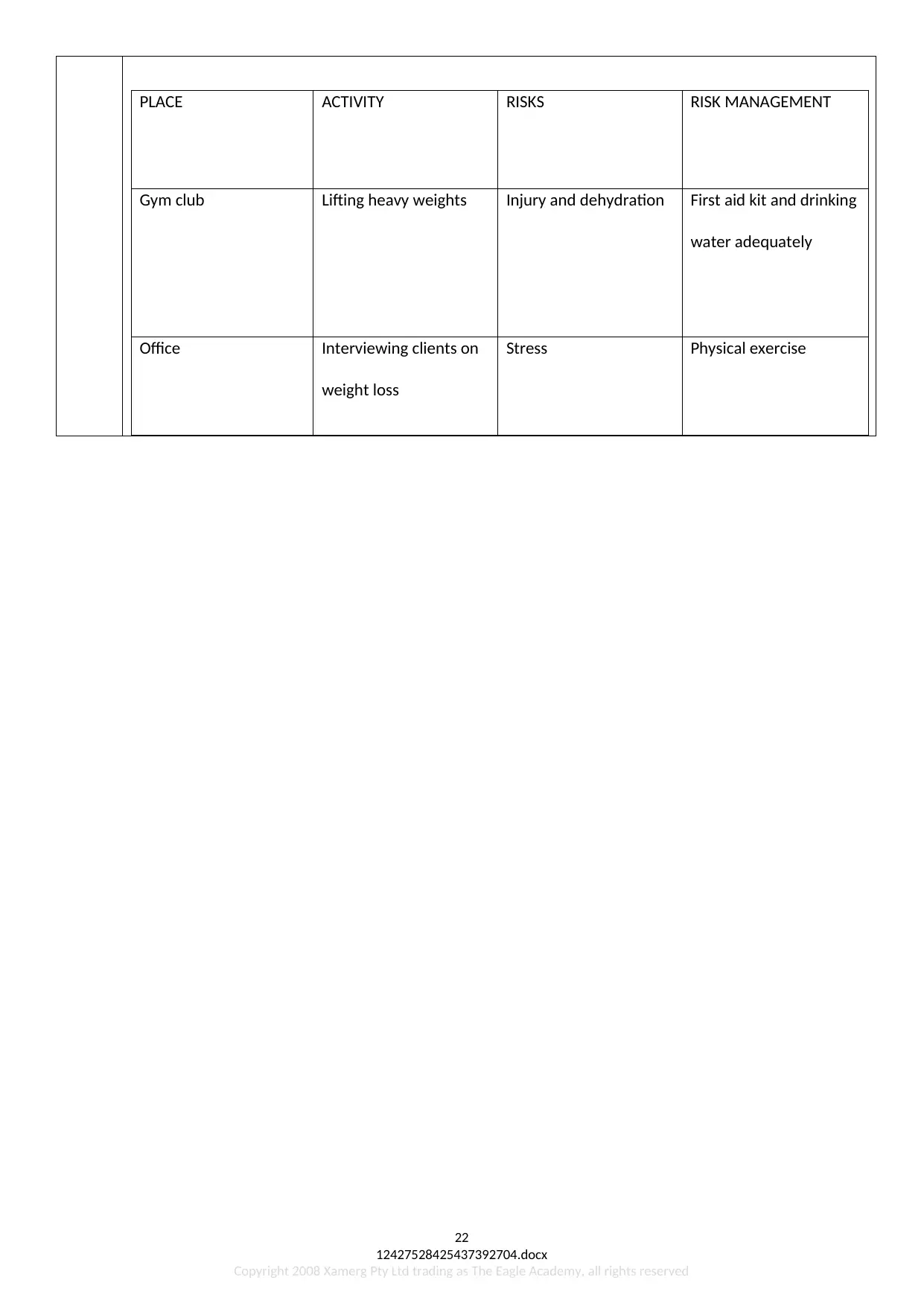
PLACE ACTIVITY RISKS RISK MANAGEMENT
Gym club Lifting heavy weights Injury and dehydration First aid kit and drinking
water adequately
Office Interviewing clients on
weight loss
Stress Physical exercise
22
12427528425437392704.docx
Copyright 2008 Xamerg Pty Ltd trading as The Eagle Academy, all rights reserved
Gym club Lifting heavy weights Injury and dehydration First aid kit and drinking
water adequately
Office Interviewing clients on
weight loss
Stress Physical exercise
22
12427528425437392704.docx
Copyright 2008 Xamerg Pty Ltd trading as The Eagle Academy, all rights reserved
Secure Best Marks with AI Grader
Need help grading? Try our AI Grader for instant feedback on your assignments.
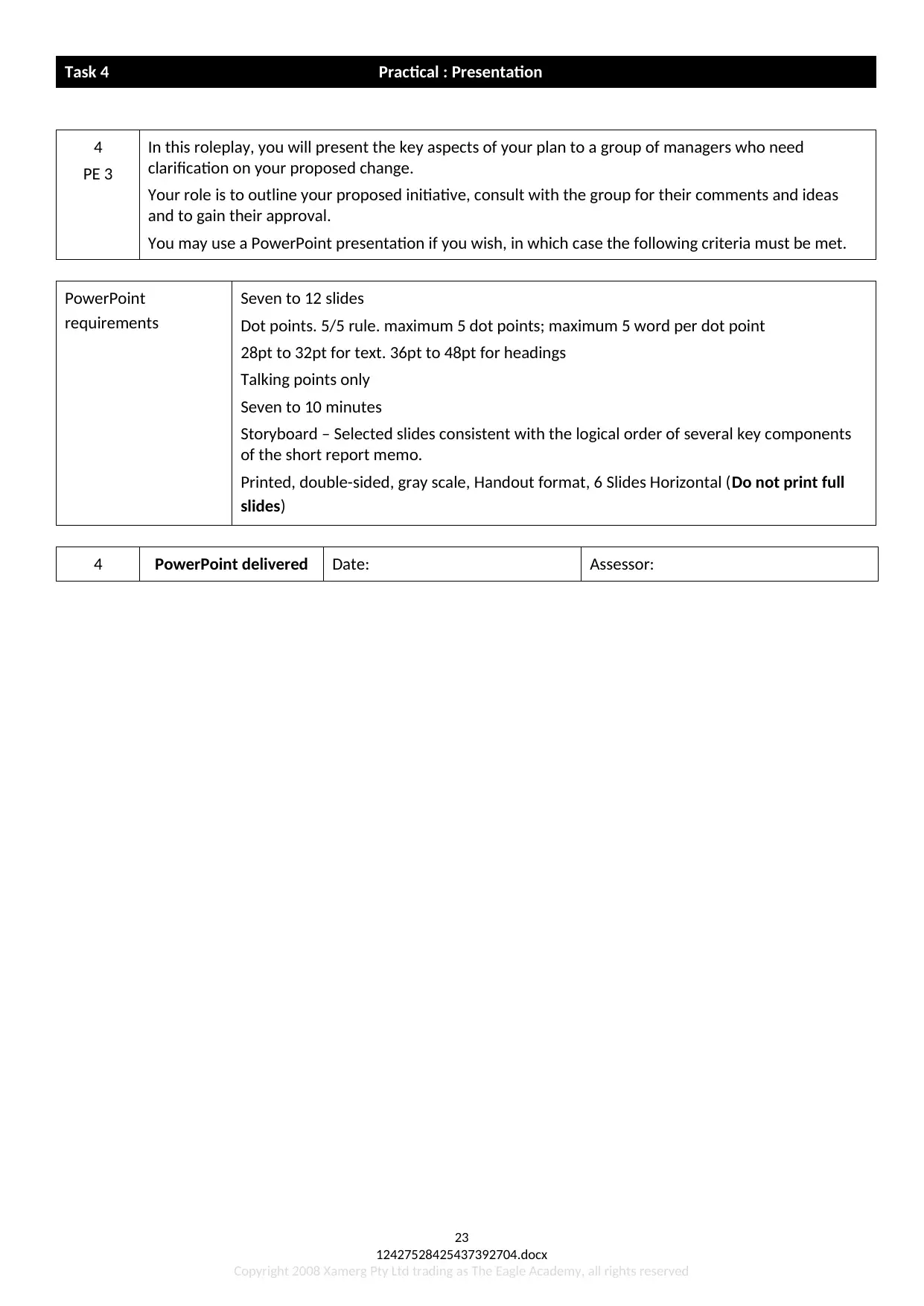
Task 4 Practical : Presentation
4
PE 3
In this roleplay, you will present the key aspects of your plan to a group of managers who need
clarification on your proposed change.
Your role is to outline your proposed initiative, consult with the group for their comments and ideas
and to gain their approval.
You may use a PowerPoint presentation if you wish, in which case the following criteria must be met.
PowerPoint
requirements
Seven to 12 slides
Dot points. 5/5 rule. maximum 5 dot points; maximum 5 word per dot point
28pt to 32pt for text. 36pt to 48pt for headings
Talking points only
Seven to 10 minutes
Storyboard – Selected slides consistent with the logical order of several key components
of the short report memo.
Printed, double-sided, gray scale, Handout format, 6 Slides Horizontal (Do not print full
slides)
4 PowerPoint delivered Date: Assessor:
23
12427528425437392704.docx
Copyright 2008 Xamerg Pty Ltd trading as The Eagle Academy, all rights reserved
4
PE 3
In this roleplay, you will present the key aspects of your plan to a group of managers who need
clarification on your proposed change.
Your role is to outline your proposed initiative, consult with the group for their comments and ideas
and to gain their approval.
You may use a PowerPoint presentation if you wish, in which case the following criteria must be met.
PowerPoint
requirements
Seven to 12 slides
Dot points. 5/5 rule. maximum 5 dot points; maximum 5 word per dot point
28pt to 32pt for text. 36pt to 48pt for headings
Talking points only
Seven to 10 minutes
Storyboard – Selected slides consistent with the logical order of several key components
of the short report memo.
Printed, double-sided, gray scale, Handout format, 6 Slides Horizontal (Do not print full
slides)
4 PowerPoint delivered Date: Assessor:
23
12427528425437392704.docx
Copyright 2008 Xamerg Pty Ltd trading as The Eagle Academy, all rights reserved
1 out of 23
Your All-in-One AI-Powered Toolkit for Academic Success.
+13062052269
info@desklib.com
Available 24*7 on WhatsApp / Email
![[object Object]](/_next/static/media/star-bottom.7253800d.svg)
Unlock your academic potential
© 2024 | Zucol Services PVT LTD | All rights reserved.
